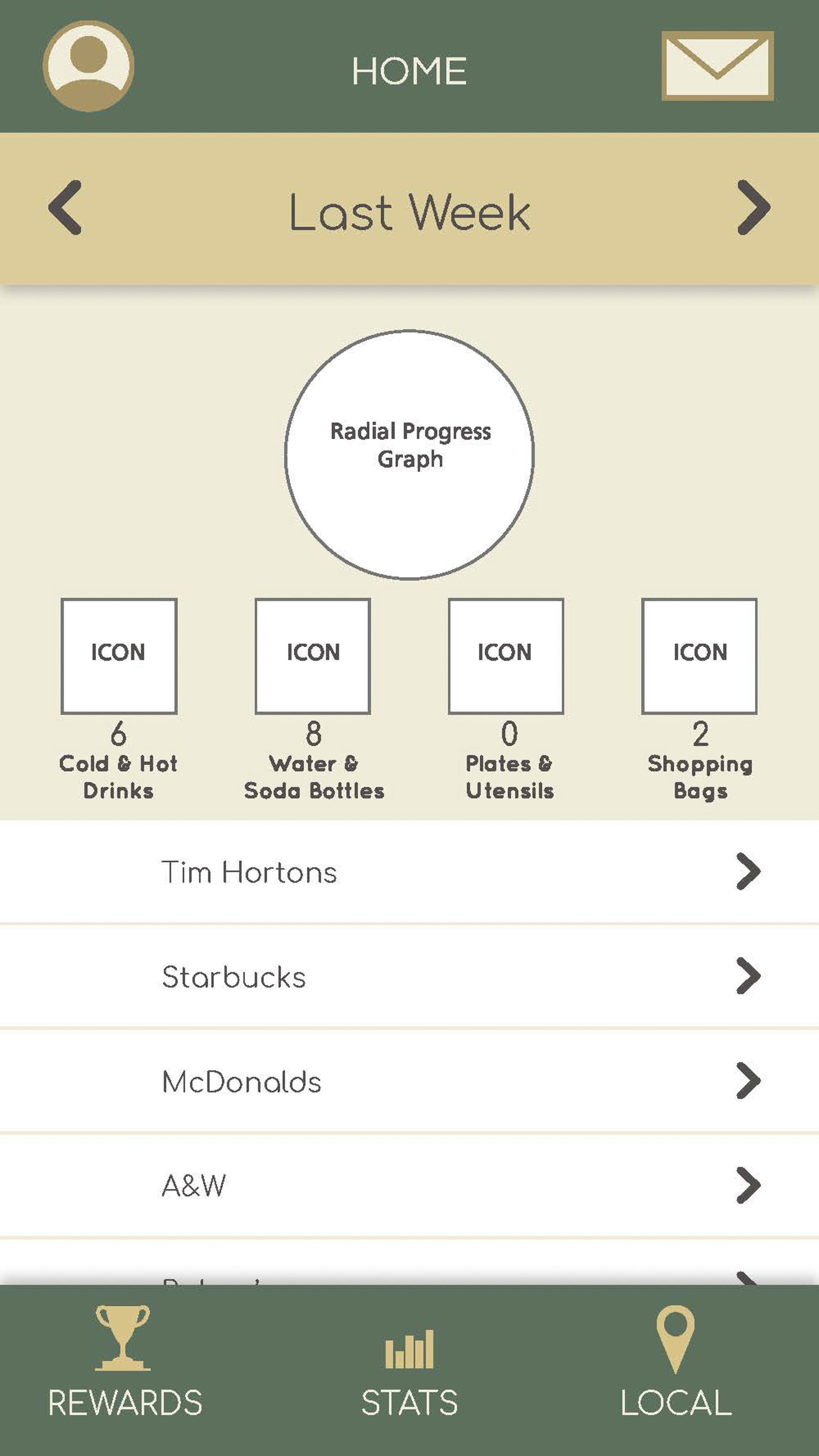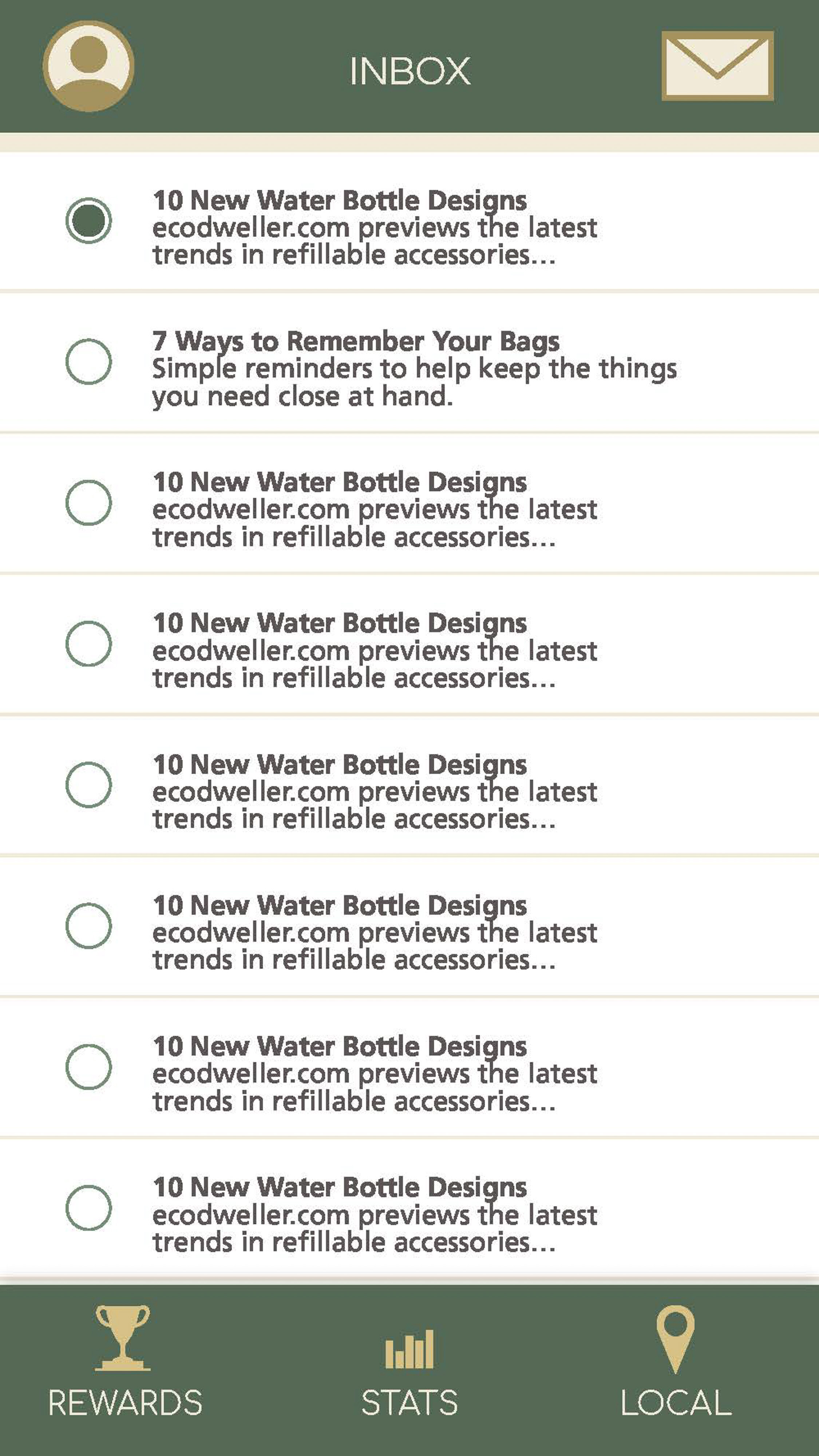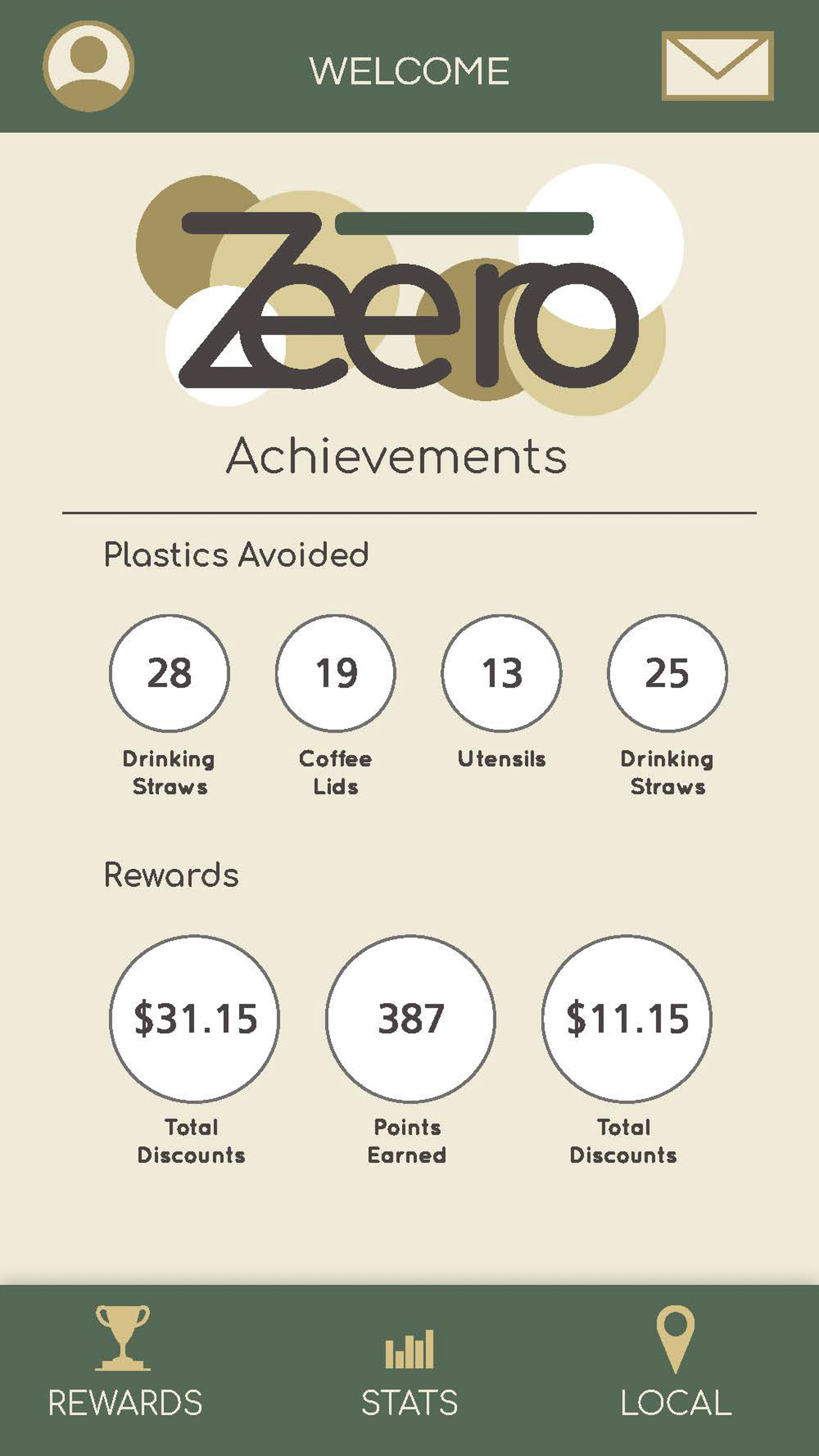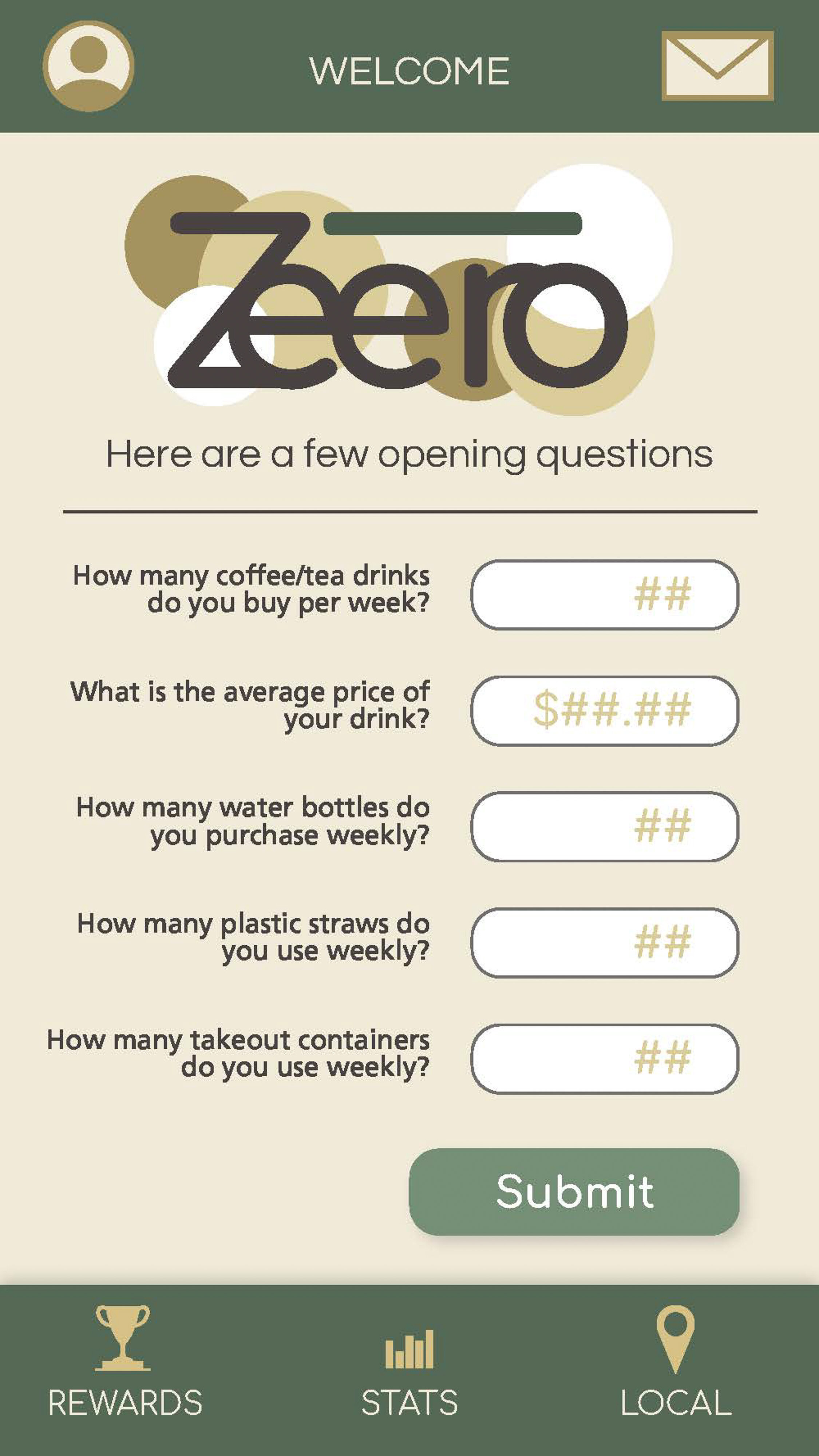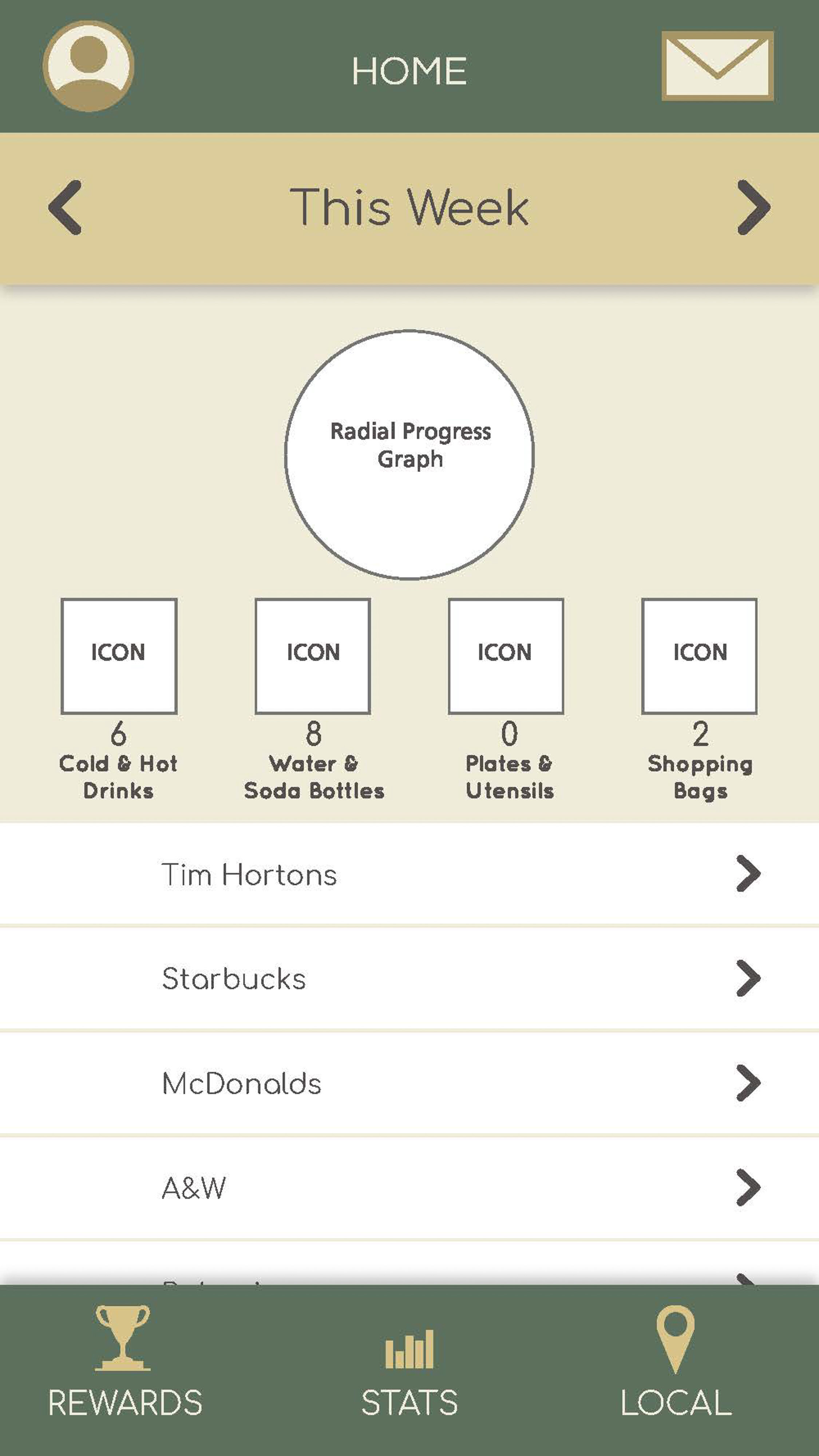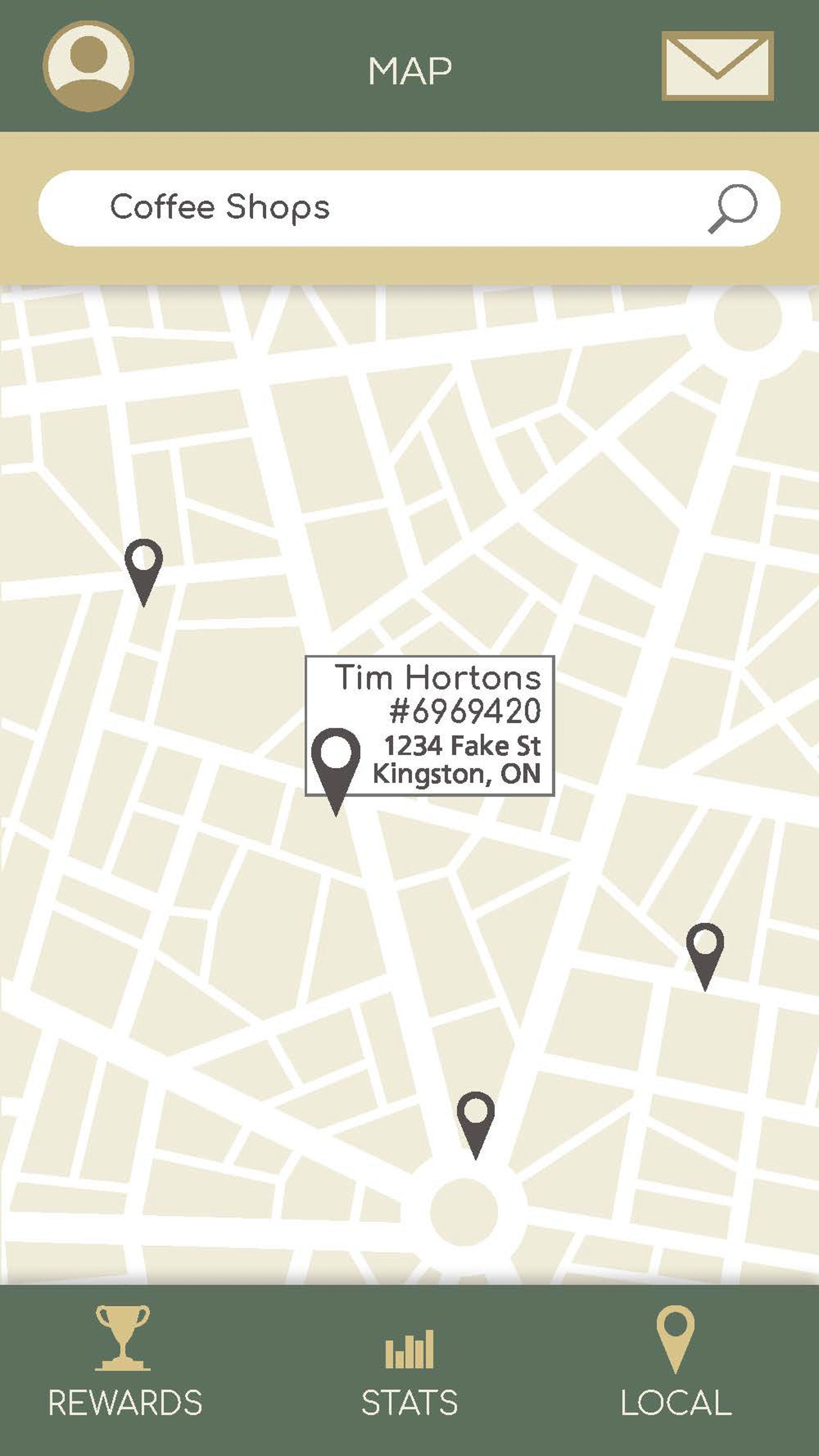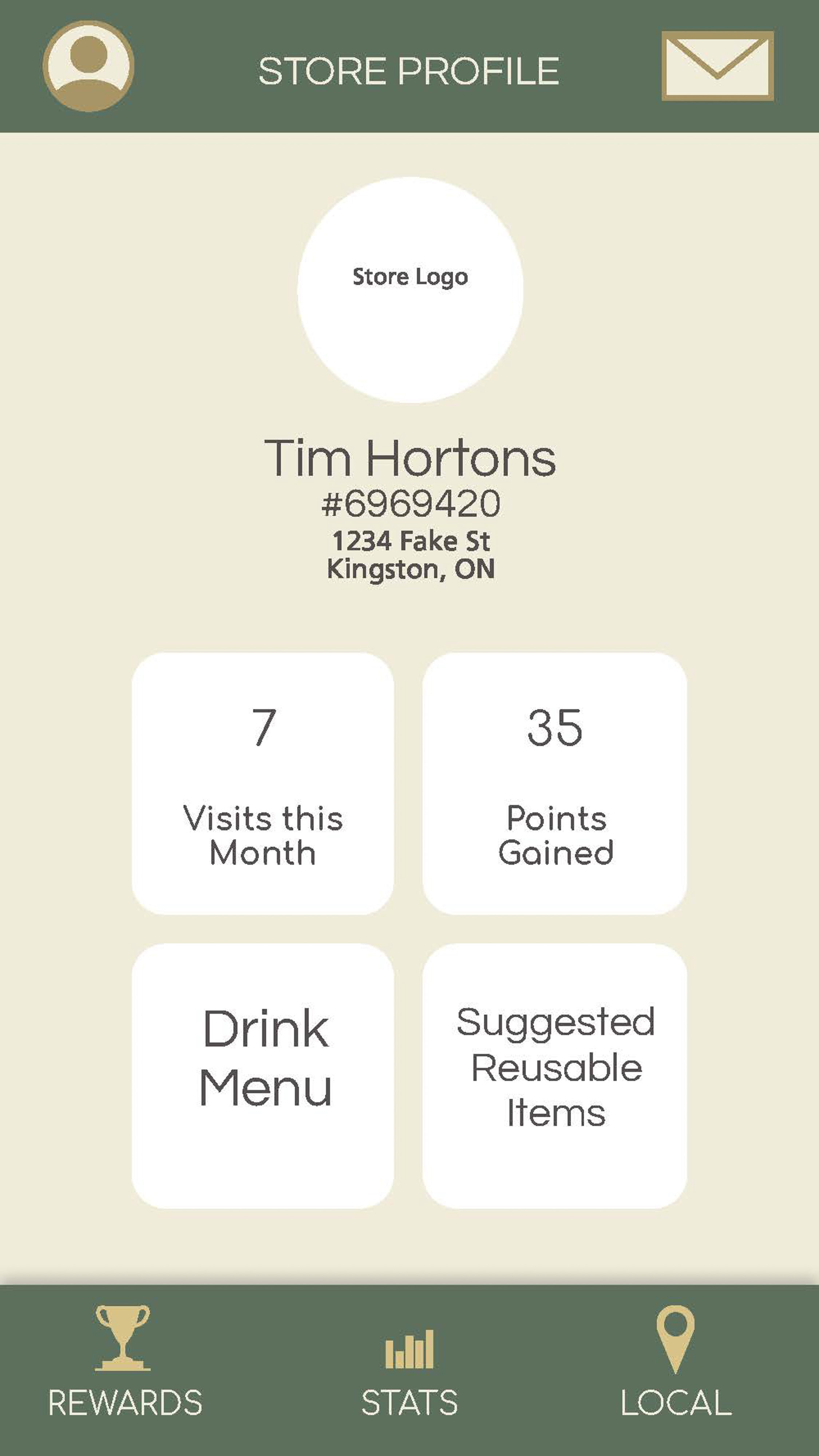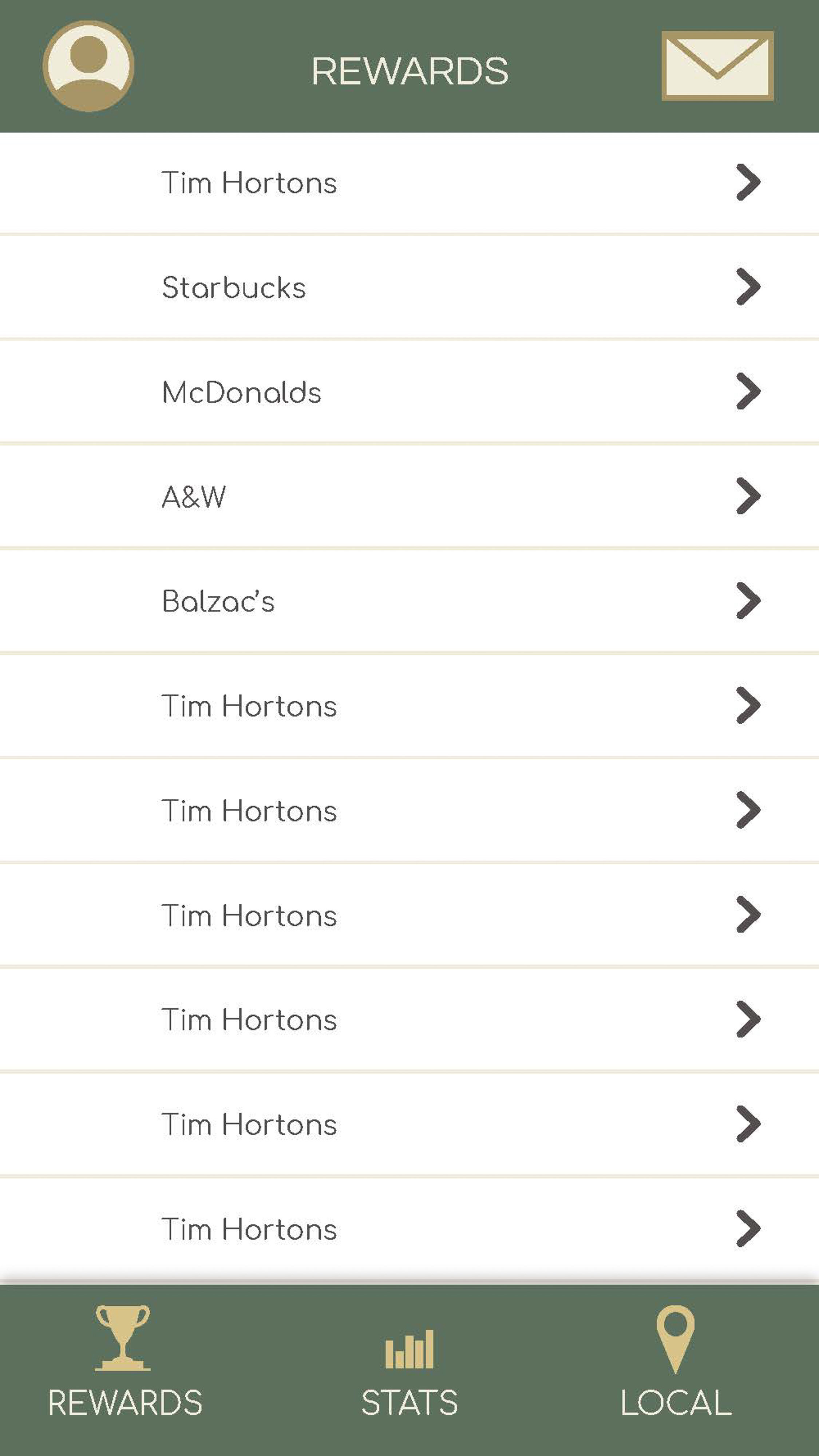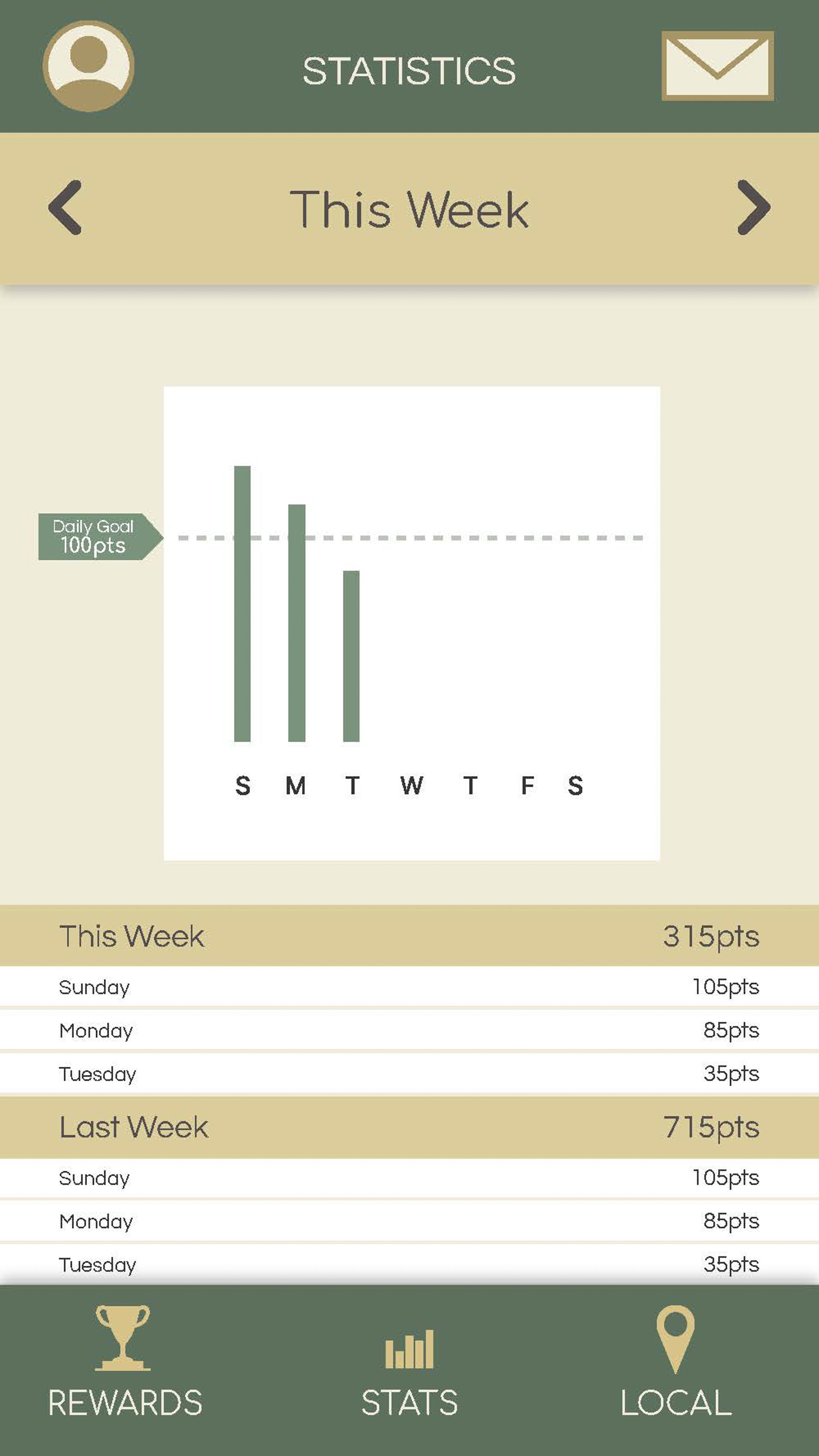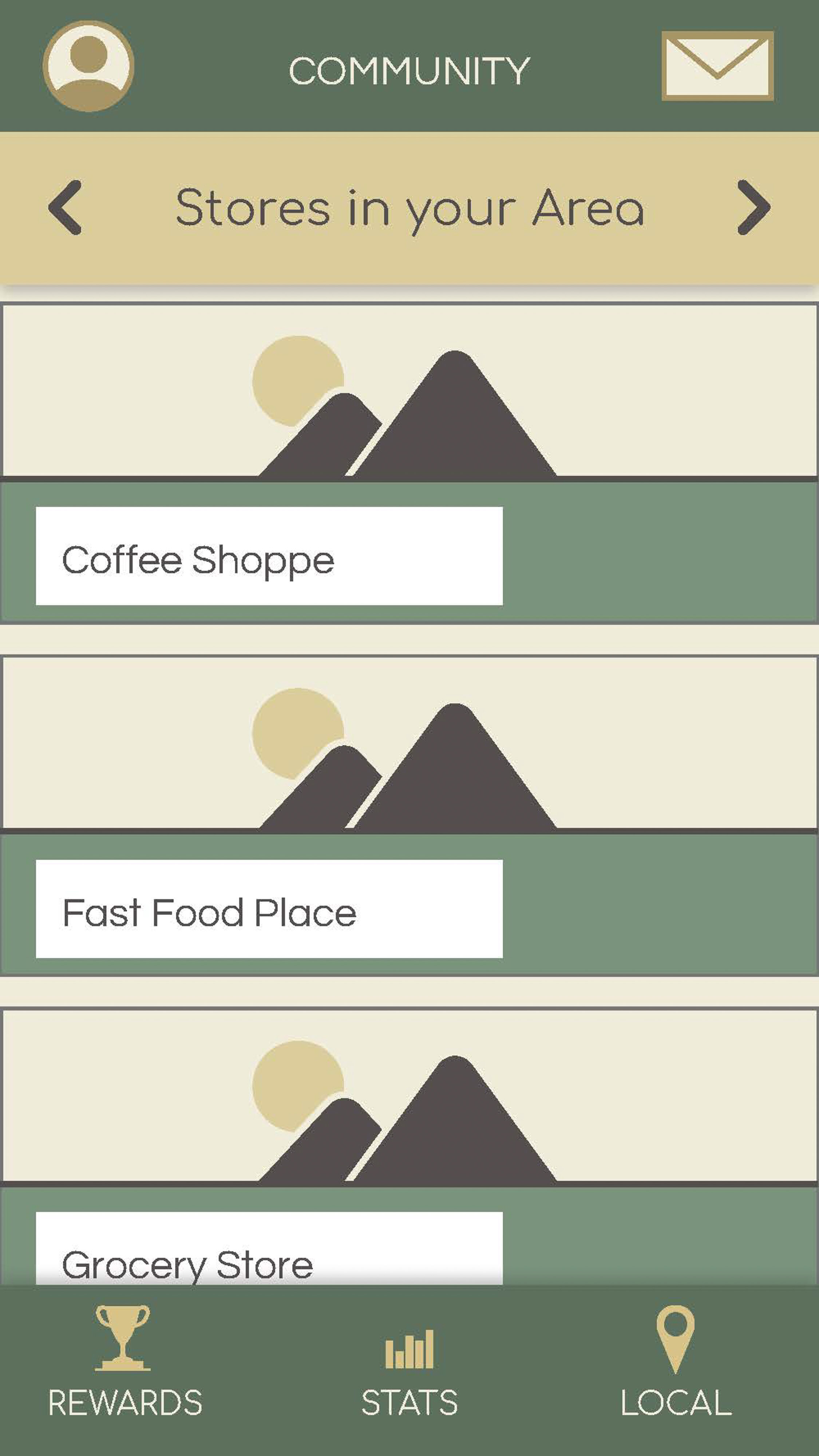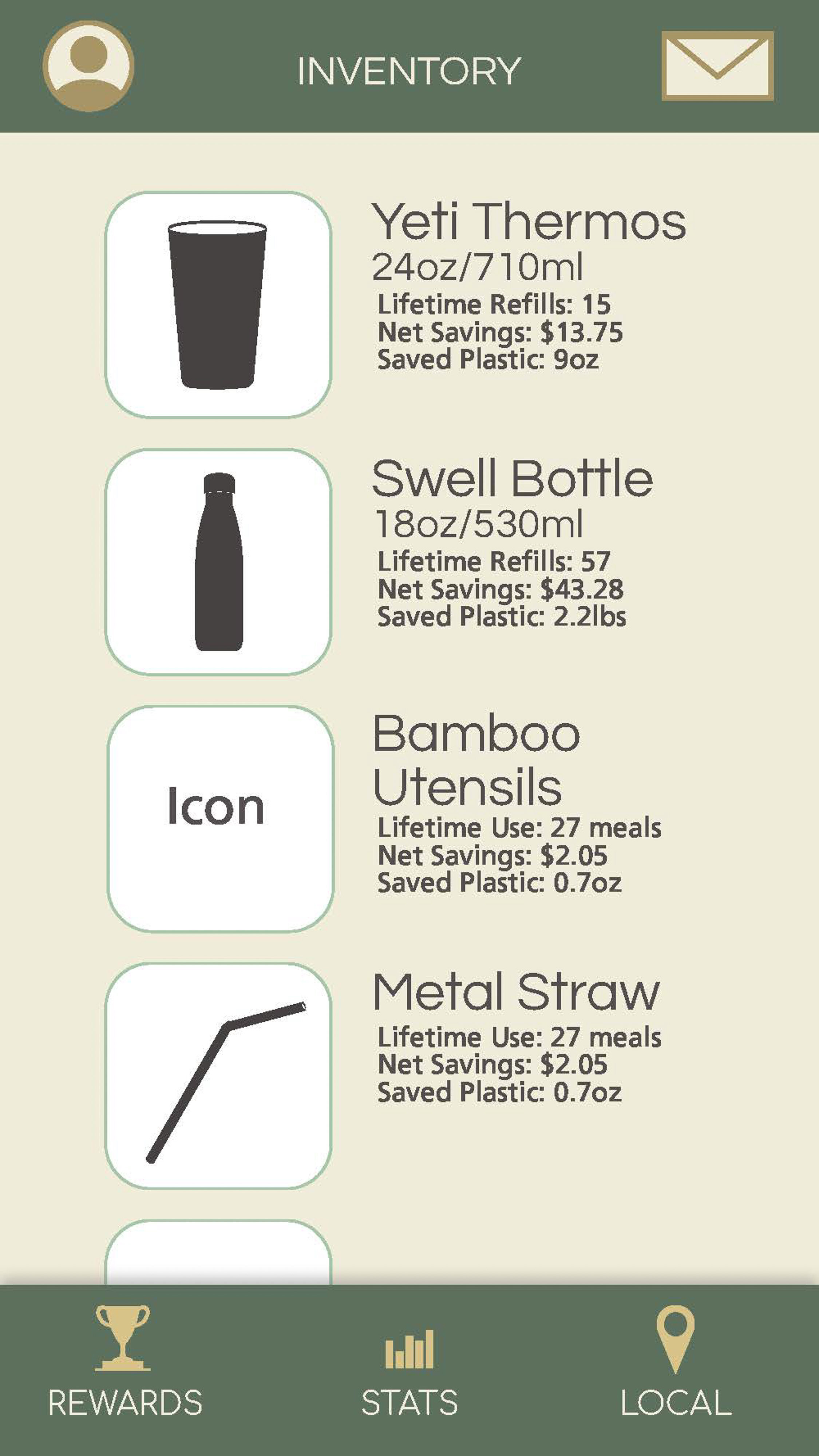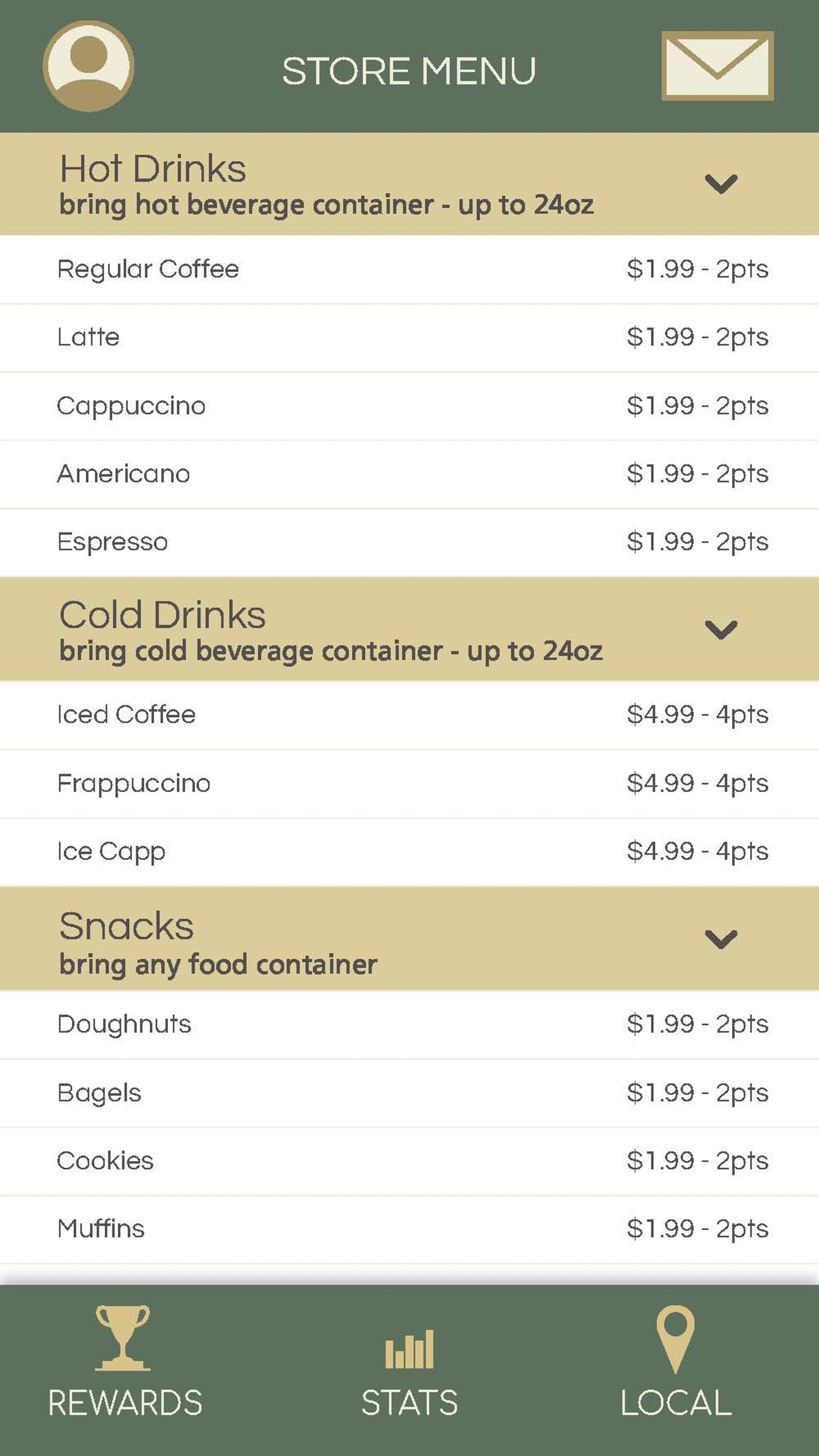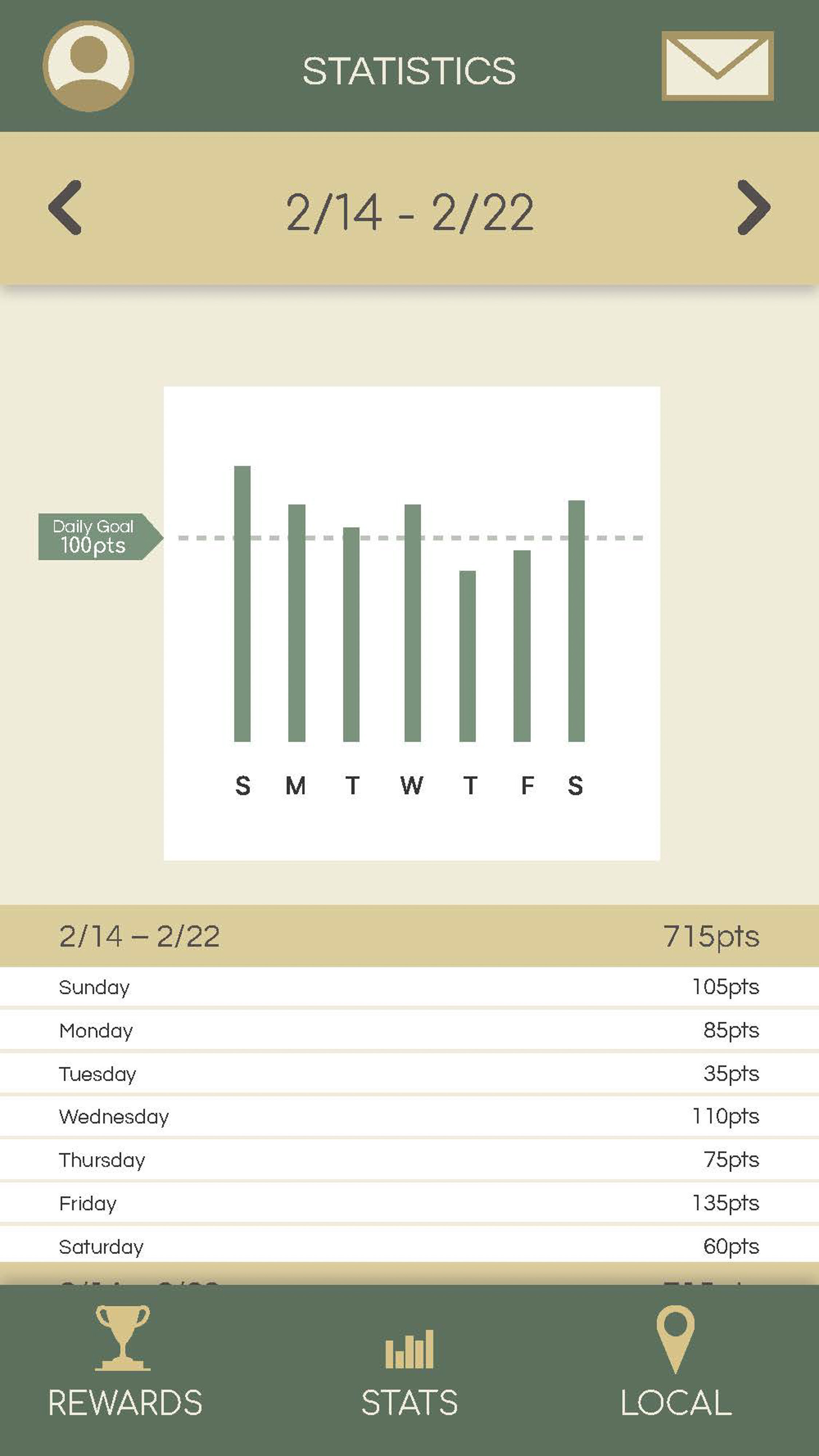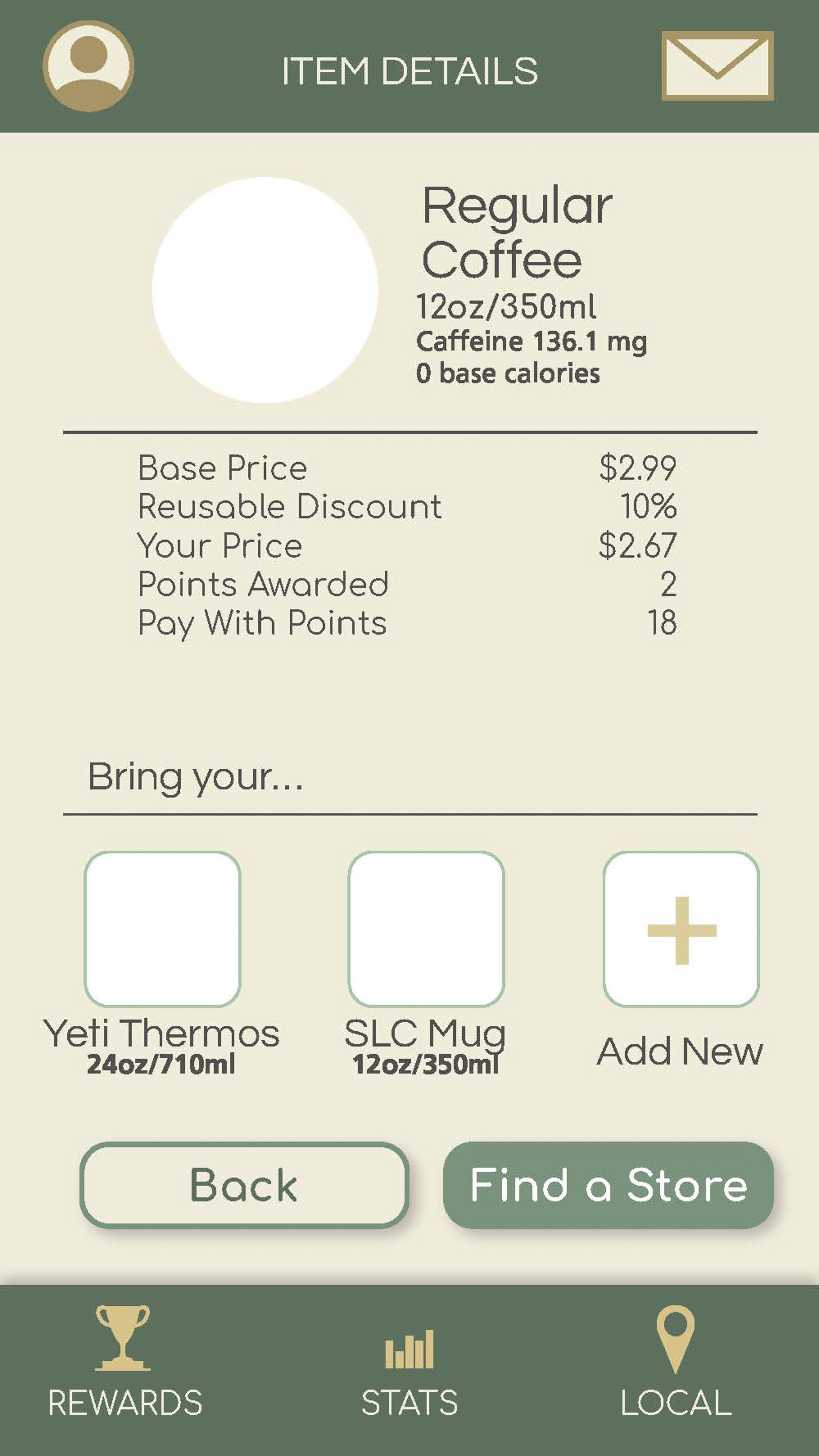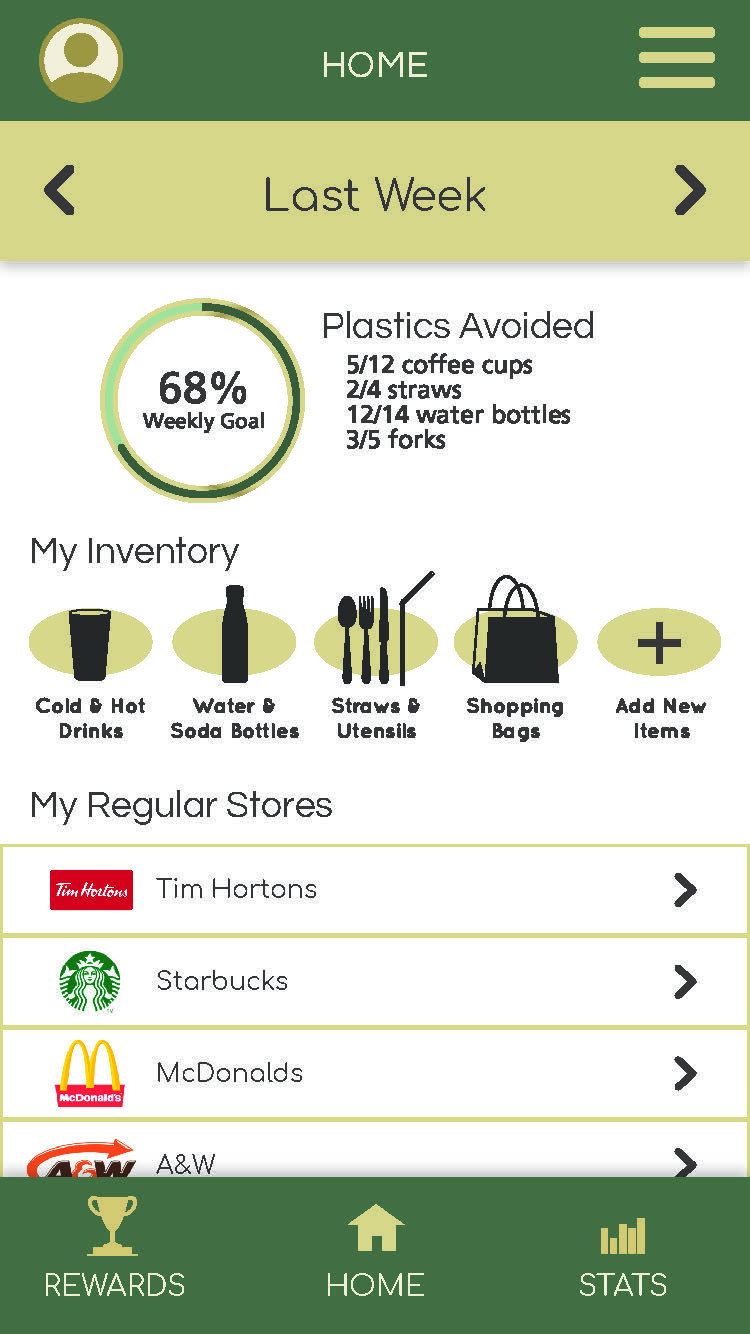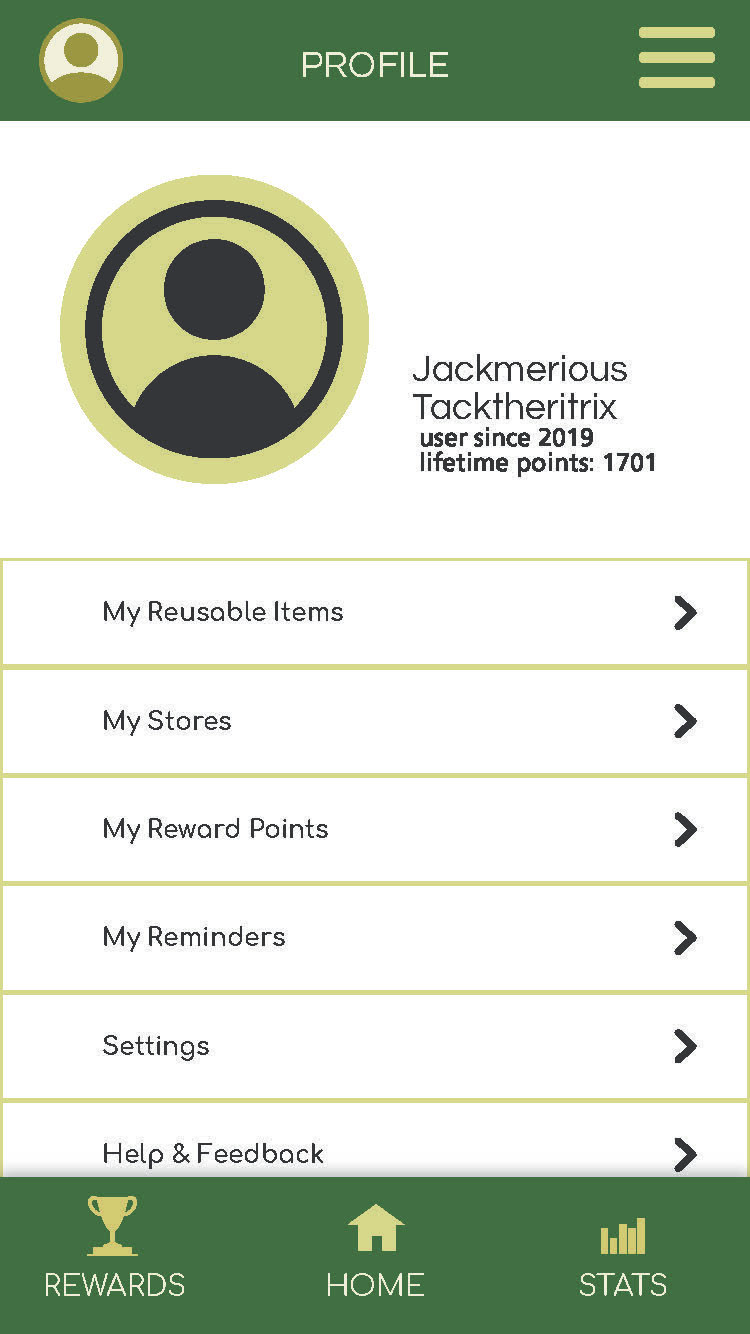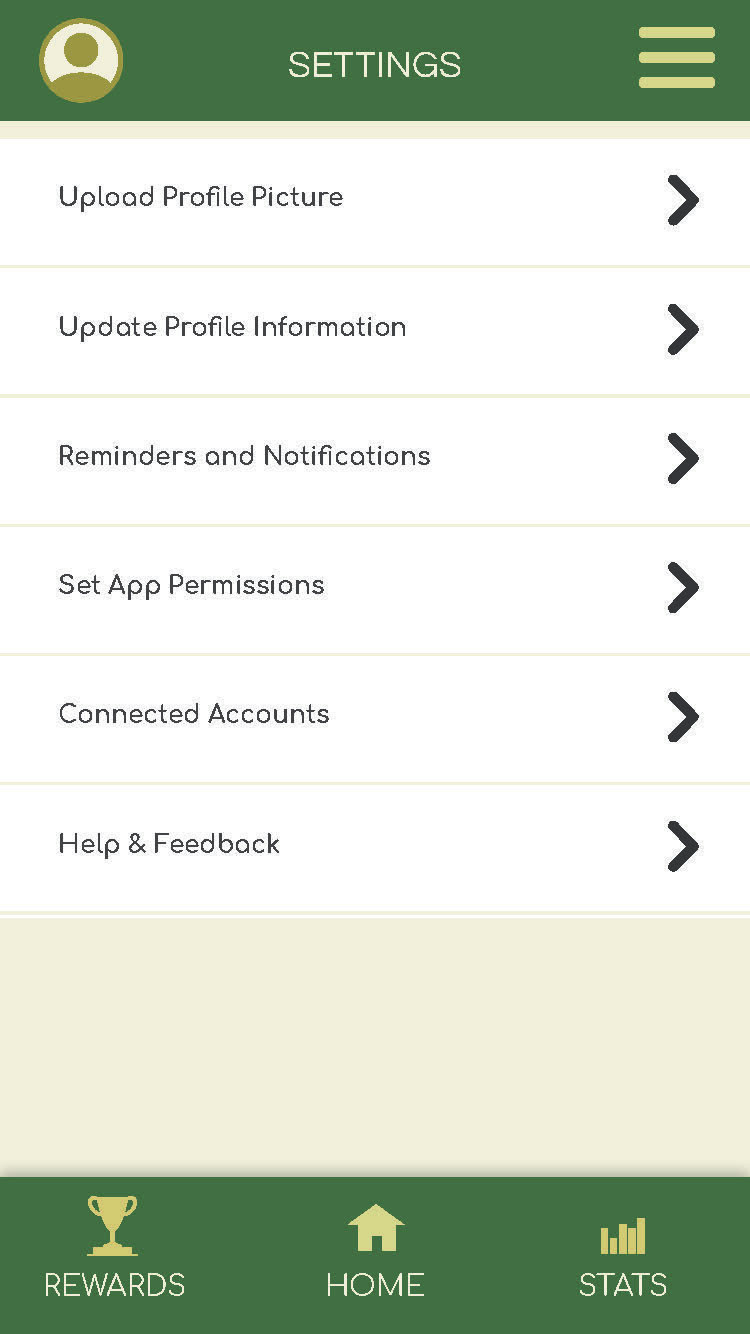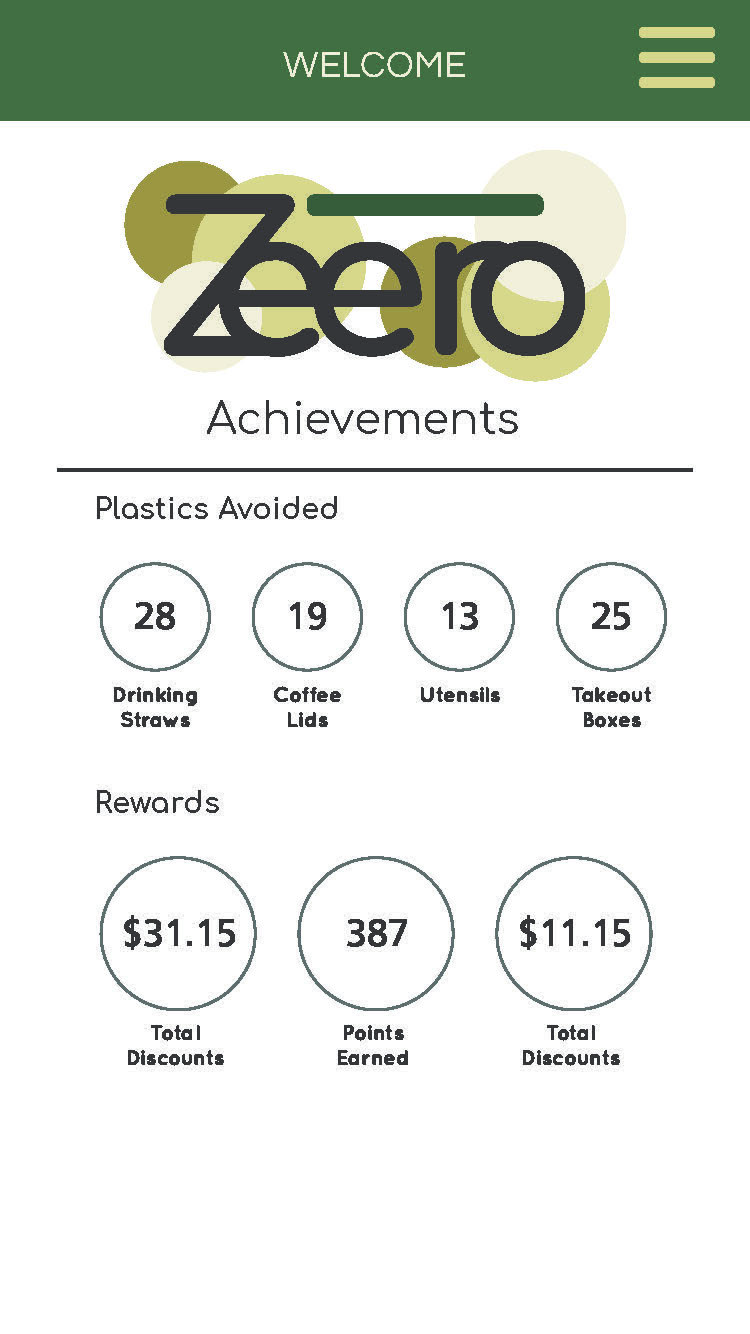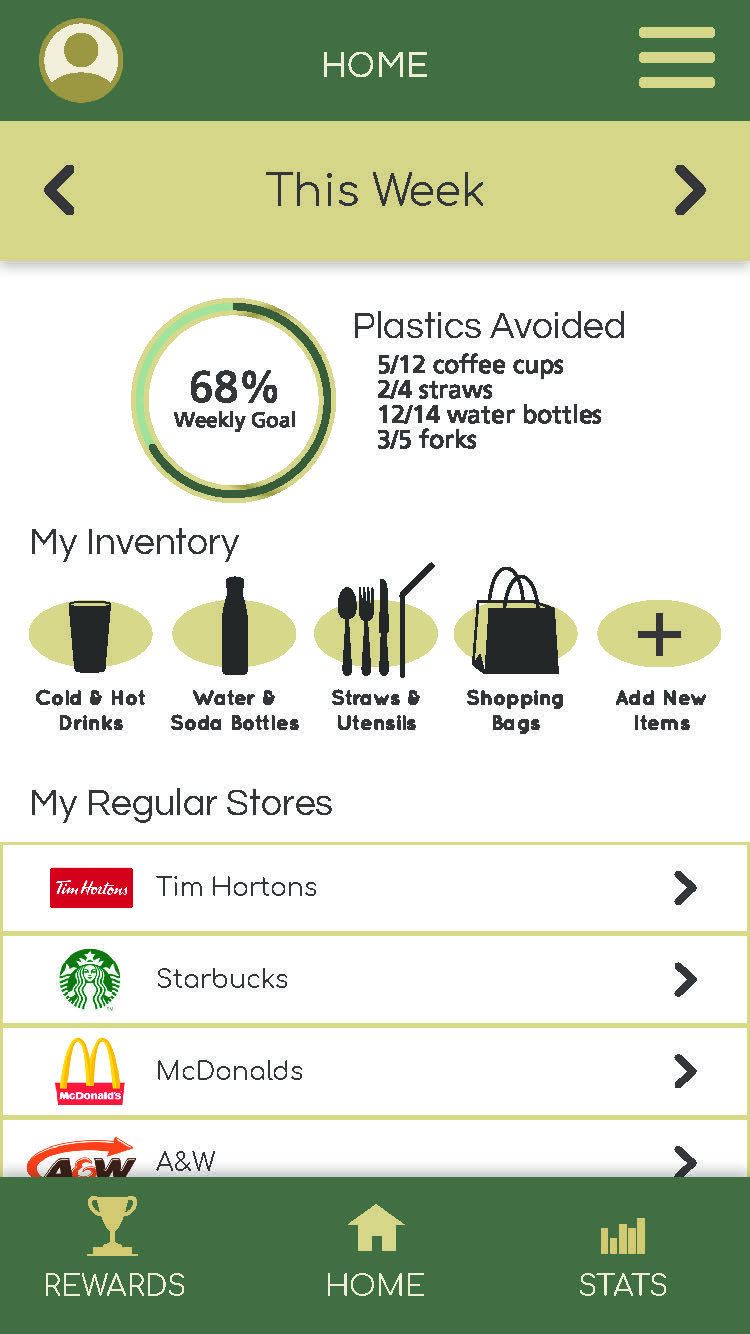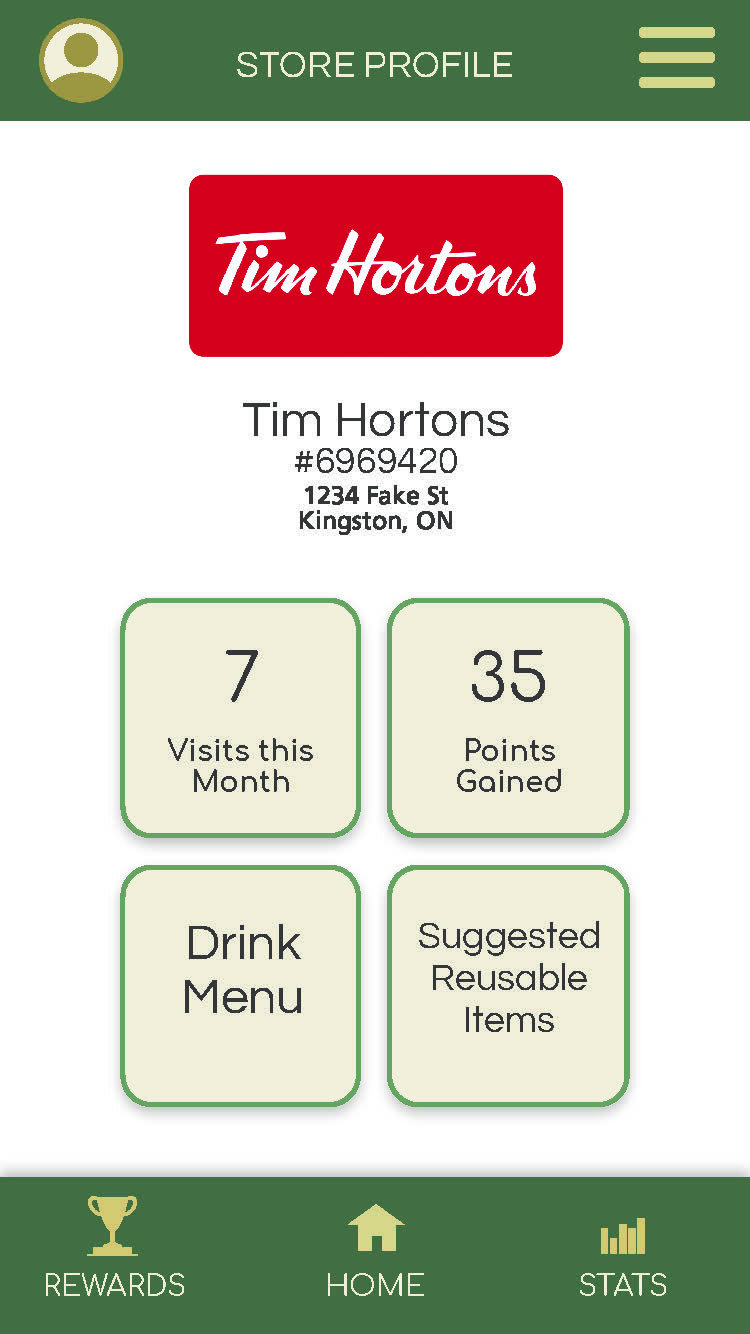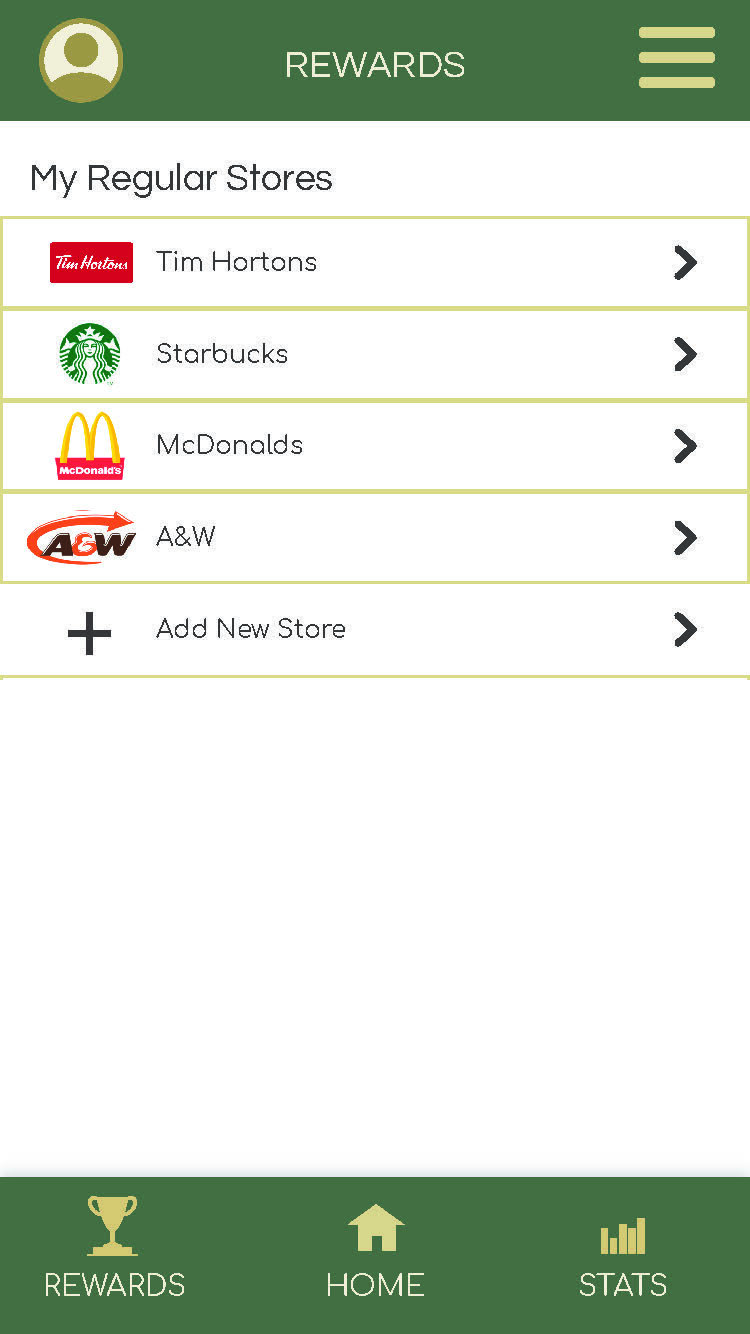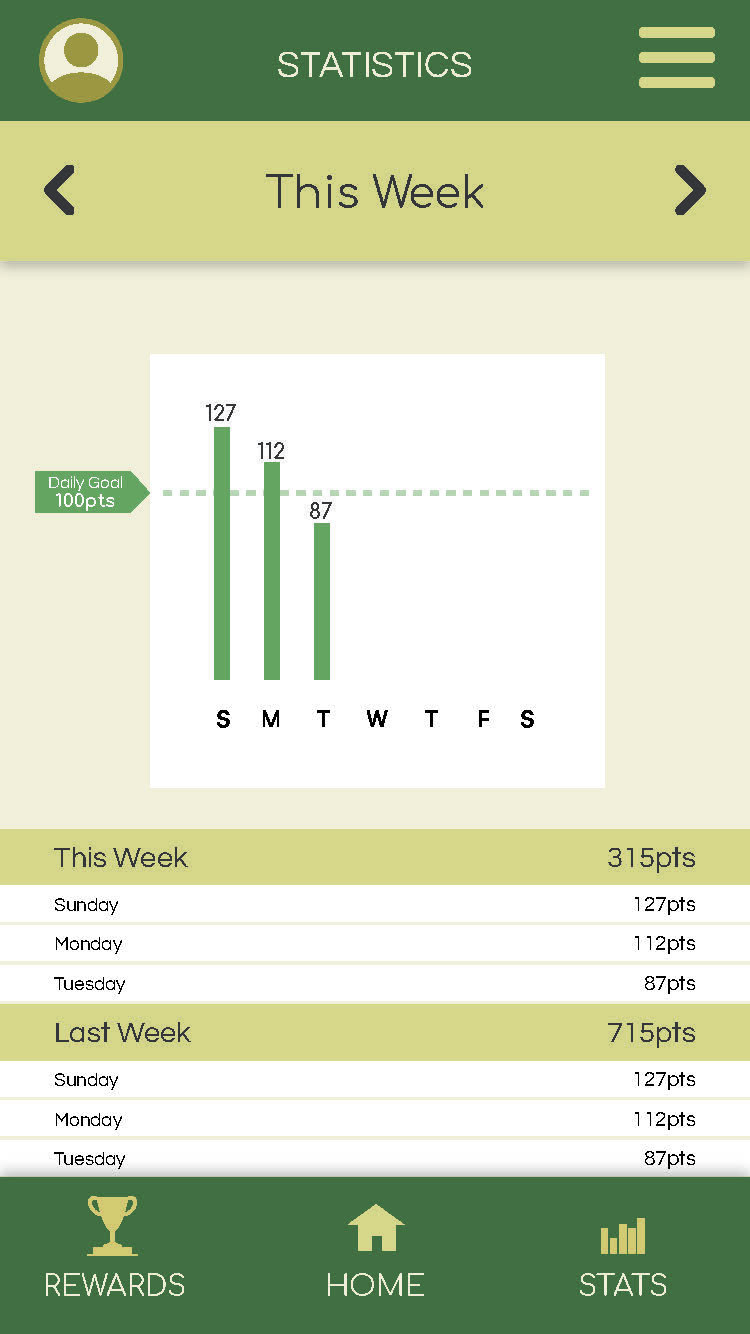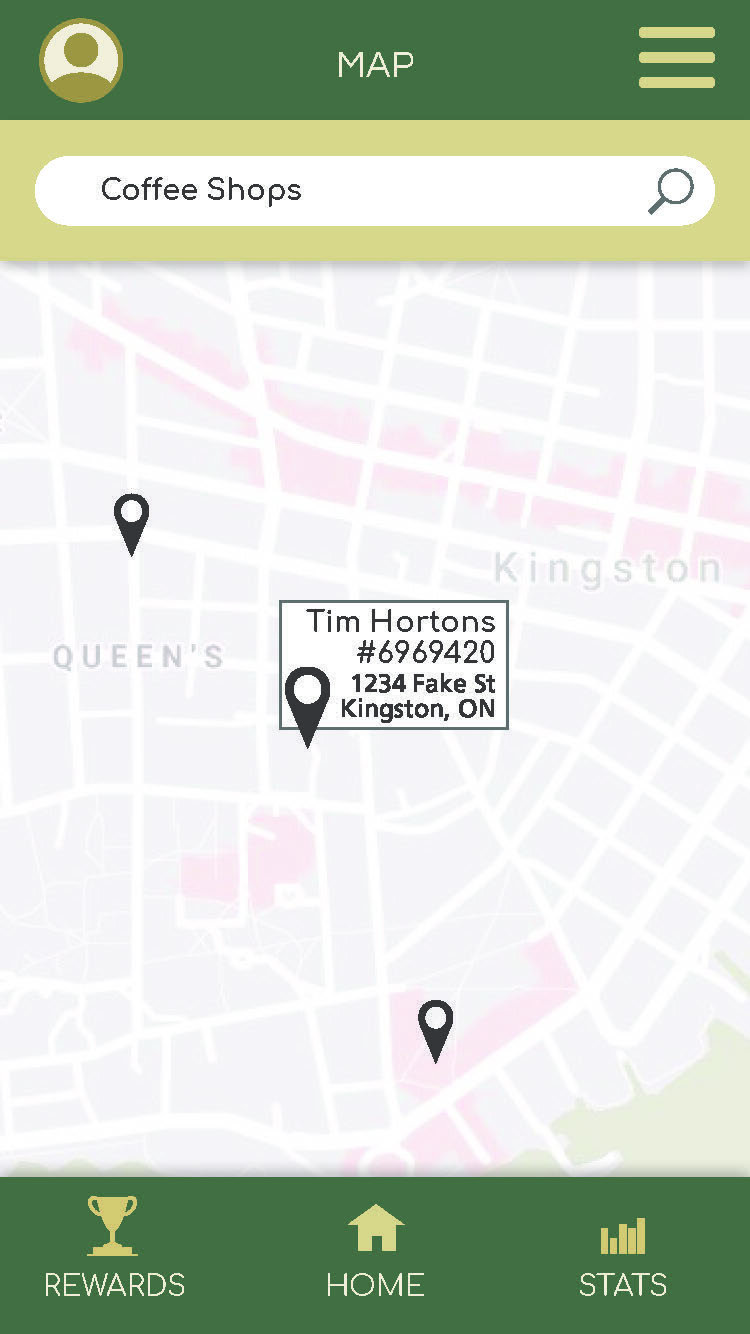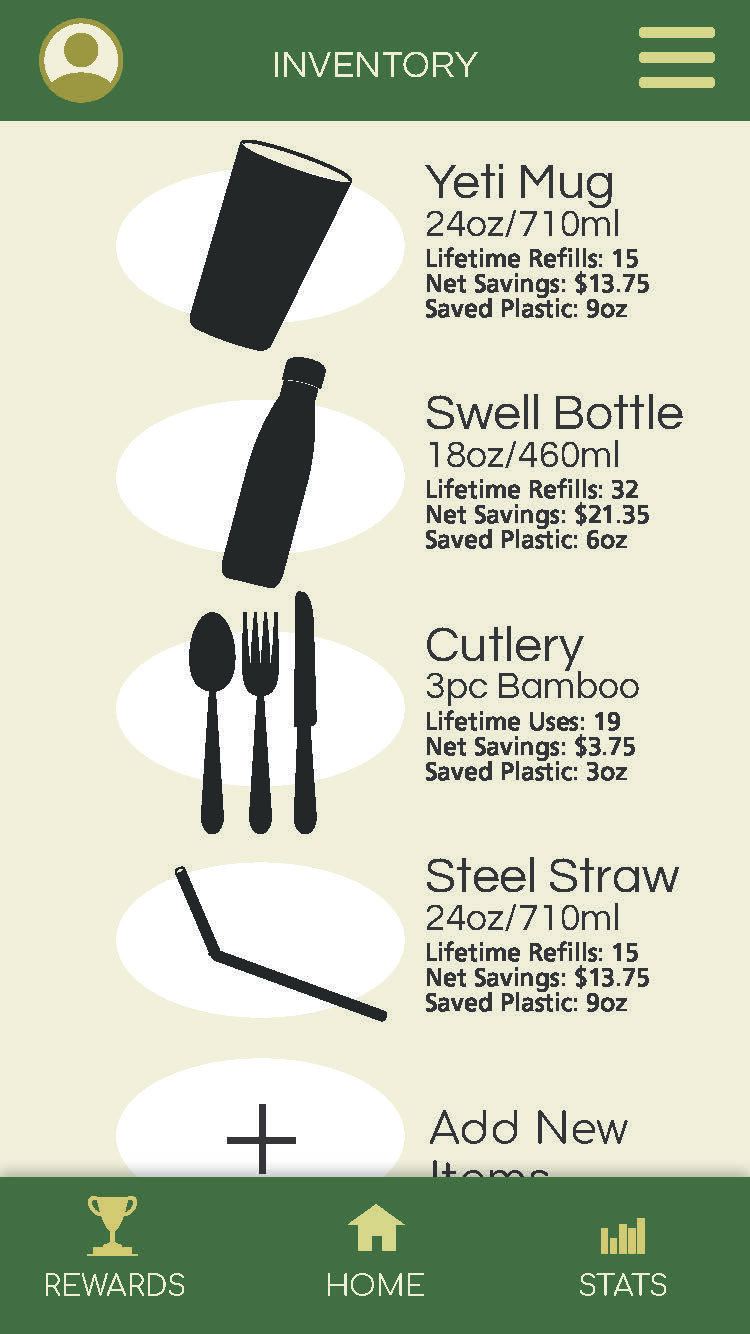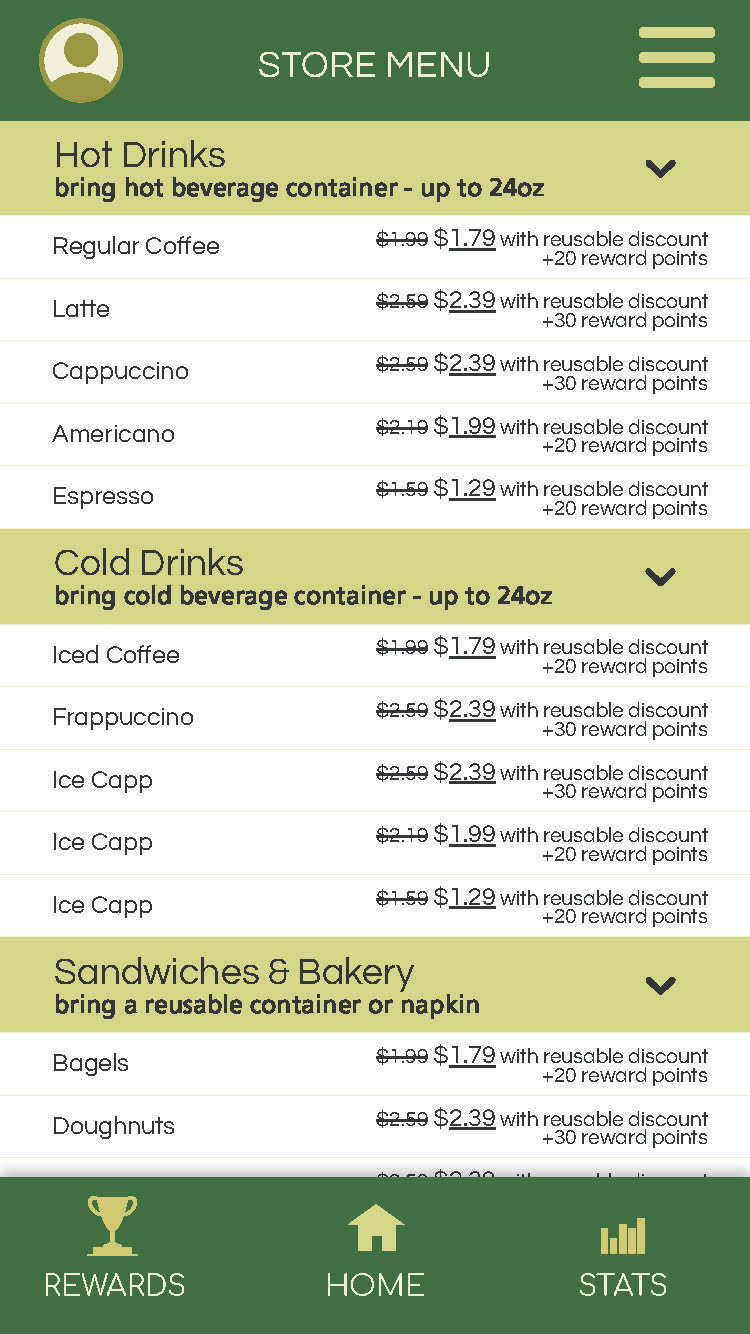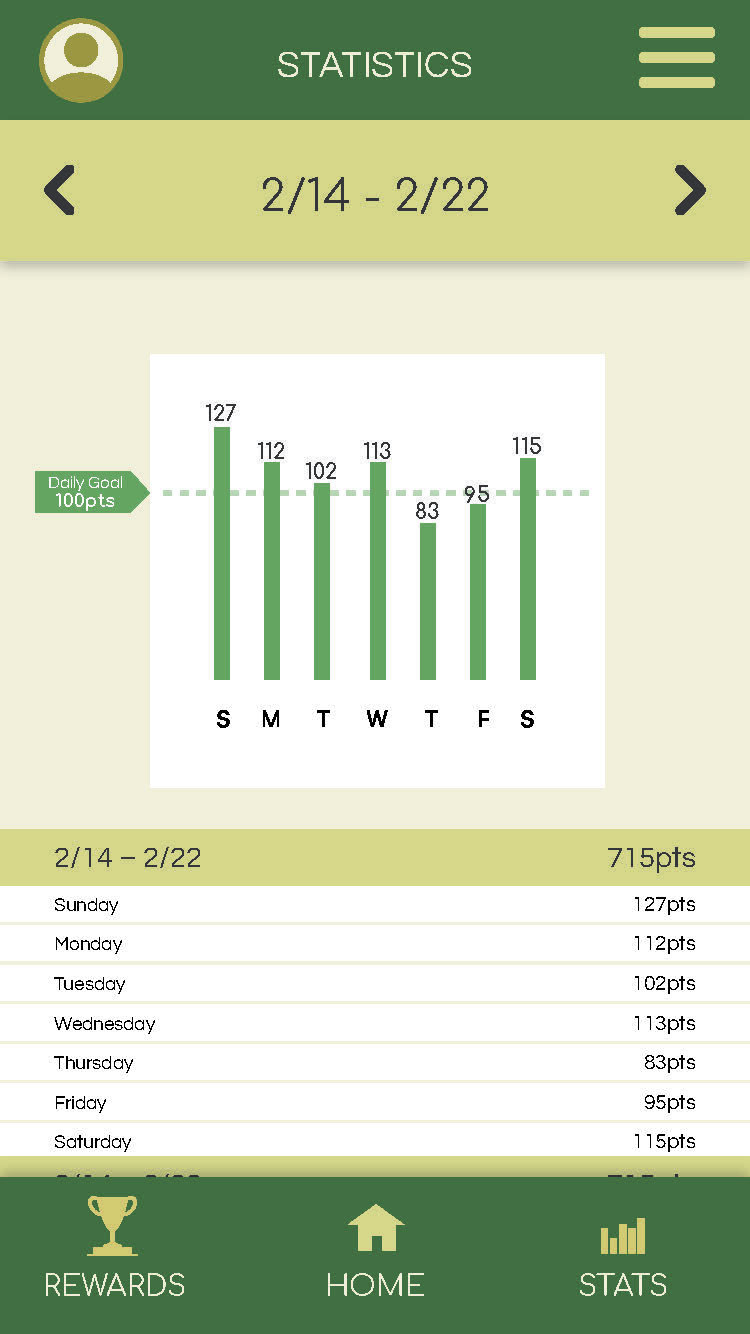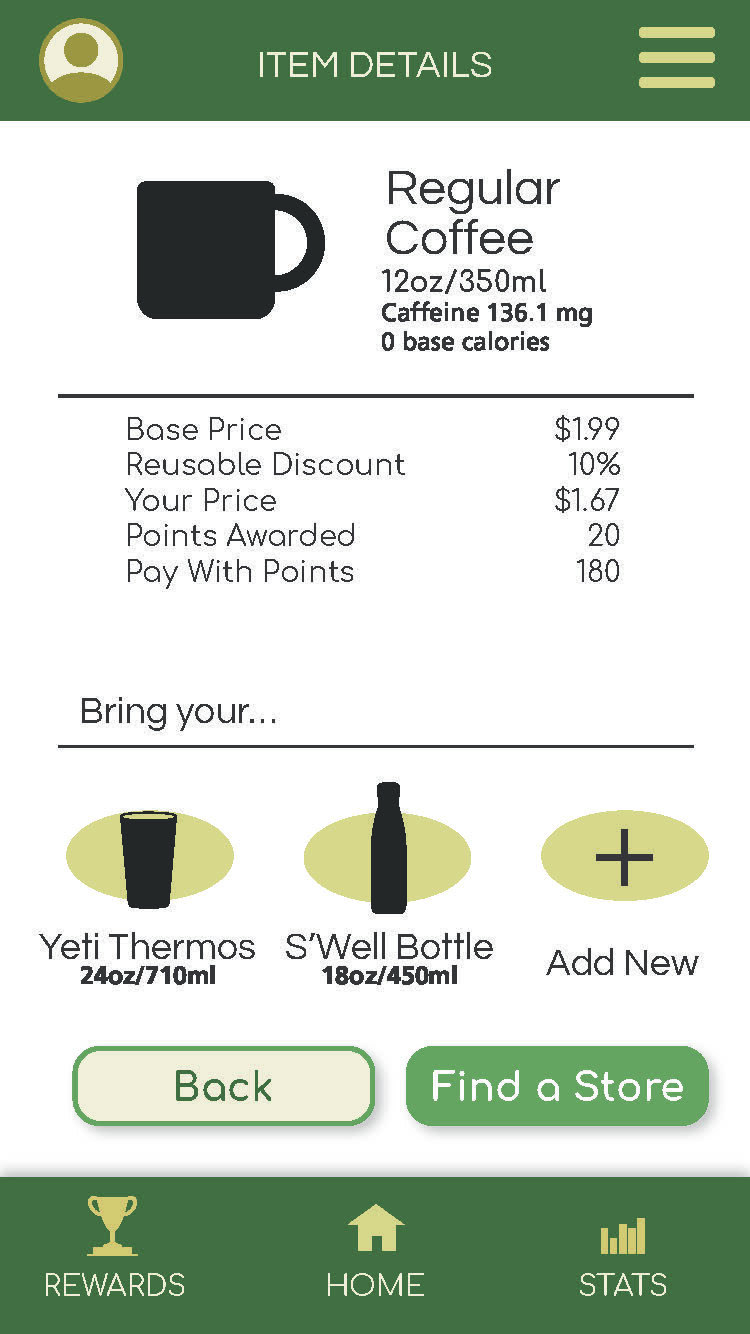Zeero® Waste Habit Tracking App
An extensively researched work of design thinking
Problem Statement
Current State
Consumer demand for convenience incentivises companies to produce single-use containers for consumable products.
The field of design and advertising has a big impact on society. Average people do not seek out museum exhibits or art installations, but they do see hundreds of advertisements a day. Scenes and images depicted in commercials are fundamentally aiming to reflect reality while also selling a product. When McDonalds shows a multi-ethnic family or TD Bank shows a single-sex couple, these images have a slow subconscious effect on social norms. Obviously, many of these decisions come from a room full of executives aimed only at profits, but it takes a designer to show them what a good idea might look like.
Graphic Design inadvertently encourages bad environmental behaviour in several ways. When a product is improved, a wise company changes the package to reflect the improvement of the product at a glance. Even when the product is unchanged, a company can boost sales of a product by simply changing its packaging. A redesigned service with new features is always more desirable than a removal of service. In an effort to improve its business, a company becomes less eco-friendly.
While good citizens will make the effort to put their waste in proper bins, the single-use item carries no real repercussions for anyone who chooses to discard their used coffee cup anywhere. Businesses must devote time and energy to keep their storefront clear of unsightly waste. Overflowing trash bins and random litter cause displeasure to viewers. A popular and thriving coffee shop might appear to be poorly managed due to the amount of trash a customer might encounter.
In reality, most North Americans can completely ignore this problem and suffer no consequences. Those who do confront the problem work in waste management or any job that requires waste bins changed regularly. Even these people may not be affected despite having to confront it every day. The ability to turn a blind eye is the central crux of the problem.
The main target audience is between age twenty and forty, works an office job, and in the process of starting a family or raising small children. They have a very predictable routine which involves fairly regular trips to fast food or coffee shops. They do not place environmentalism high on their daily priorities or concerns. They use recycling bins and make a reasonable effort, but they do not devote any extra time towards becoming more sustainable through research or actions. They may feel there is not enough time in the day to make any significant changes to their routine.
Who is affected by single-use items? Natural locations such as parks and hiking areas suffer greatly as they do not tend to employ full time custodial staff. Arguably the biggest victims are the plants and animals who must live among plastic – something entirely foreign to the natural world. Animals can easily become entangled in garbage or they can be injured trying to eat something sharp and indigestible. People are affected by disturbing news of extreme pollution and feel ashamed of their society when it occurs close to home.
What is affected by single-use items? In addition to wildlife habitats, residential areas suffer the effects. The relative wealth of people living in an area dictates how clean an environment is. The poorest communities suffer the most because they lack the funds necessary to fight the influx of garbage. The national and global economy is affected by the need to continue producing these items. Improvements to the production cycle would improve environmental conditions and also free up energy that is currently used to produce and dispose of single-use items.
When and where are single-use items problematic? The problem occurs whenever a single-use item is purchased. It exists whenever a public trashcan promises to recycle the waste. Whenever a business makes purchasing and discarding so forgettable and easy, bad habits are reinforced.
Why do single-use items exist? Convenience is simple – new systems are hard. If you want to sell more products, you should make your product easier to use. Take the burden of effort away from the user. These values are destructive to society, but they do not apply to everything.
Ideal State
Reusable containers should become the norm. Disposing of a single-use item should be considered a shameful and regrettable act. Eco-concerns should extend beyond the obvious environmentally conscious demographics.
Consumers do not view their favorite clothing or their car as being disposable. People can become temporarily attached to small items like a Chapstick or a ballpoint pen. Conversely, they are completely detached from coffee cups and plastic forks, which are used once and forgotten. It is reasonable to believe the average user could be convinced to switch to reusable options for cutlery and drinkware without having to rely on environmentalism to make the case.
A perfect outcome would be a dramatic reduction in the consumption of single-use items over the next five years. Lower consumer demand will decrease the investment in these items. Fewer single-use items means less wasted energy overall.
An ideal state would mirror the anti-smoking progress made since the 1980s, but on a much faster timescale. In the early phases, single-use plastics would be removed from all advertising. Next, the single-use items would be only available by request, and the items would be taxed increasing each year with proceeds benefitting nature conservation. Finally, the possession of single-use plastic will be seen as a social faux-pas, much like smoking at a restaurant.
Problem Statement
The purpose of this study is to understand single-use plastic and the daily habits of typical users in order to reduce waste and develop sustainable habits for young professionals in Kingston Ontario, especially those outside of the eco-conscious demographic.
Target Audience
The main target audience is between age twenty and forty, works an office job, and in the process of starting a family or raising small children. They have a very predictable routine which involves fairly regular trips to fast food or coffee shops. They do not place environmentalism high on their daily priorities or concerns. They use recycling bins and make a reasonable effort, but they do not devote any extra time towards becoming more sustainable through research or actions. They may feel there is not enough time in the day to make any significant changes to their routine.
Literature Review
Historical and Scientific Data
The design solution will undoubtedly require the user to change their habits in some way. Understanding the basic history and science of plastic could encourage users to re-think their current habits. This information is drawn from multiple sources and covers only the most easily grasped concepts.
What is plastic? Who discovered it? Where was it first used?
Plastic is fundamentally a “polymer”. This means it is composed of long, potentially endless, chains of “monomers” that hold together tightly. Their molecular makeup means they can be very strong but also very thin. Plastic-like materials exist in nature and have been derived from plants for thousands of years. Natural resinous extracts from trees have been used as varnish, which can preserve wood and textiles for years. Rubber has been used to make toys and string-like bindings since before the common era. Early polymers were derived from organic materials like animal horns.
Modern plastic was first developed in the 1800s. Many household items at the time were made of animal bone. Combs and piano keys and other brittle light items were made from ivory. Plastic began as a more efficient and cheaper alternative.
A key breakthrough came in 1907, when Belgian-American chemist Leo Baekeland created Bakelite, the first real synthetic, mass-produced plastic. His process could predictably create a rigid material which could be injection molded into any conceivable shape.
Plastic usage grew exponentially during world war two as a replacement for glass. Plastic manufacturers were motivated to sell it to consumers after the war.
The production of modern plastics begins with the distillation of crude oil in an oil refinery. This separates the heavy crude oil into groups of lighter components, called fractions. Each fraction is a mixture of hydrocarbon chains, which differ in terms of the size and structure of their molecules. One of these fractions, naphtha, is the crucial compound for the production of plastics.
Common forms of consumer plastic
Modern plastics unfortunately have a variety of sub-divisions. One of the fundamental issues with plastic is that each variety needs its own consideration. Any recycling effort will have to develop different processes for each. In an ideal situation, the audience will not have to have this information, but realistically it would be helpful to know the difference between various plastics.
Polyethylene terephthalate (PET or PETE): John Rex Whinfield invented this polymer in 1941 by condensing ethylene glycol with terephthalic acid. The condensate was polyethylene terephthalate (PET or PETE). PET is a thermoplastic that can be drawn into fibers (like Dacron) and films (like Mylar). It's the main plastic in Ziploc™ food storage bags.
Polystyrene (Styrofoam): Polystyrene is formed by styrene molecules. The double bond between the CH2 and CH parts of the molecule rearranges to form a bond with adjacent styrene molecules, thereby producing polystyrene. It can form a hard impact-resistant plastic for furniture, electronic housing, cups, and utensils. When polystyrene is heated and air blown through the mixture, it forms Styrofoam. Styrofoam is lightweight, mouldable and an excellent insulator.
Polyvinylidene Chloride (Saran): DOW makes Saran resins, which are synthesized by polymerization of vinylidene chloride molecules (CH2=CCl2). The polymer can be drawn into films and wraps that are impermeable to food odors. Saran wrap is a popular plastic for packaging foods.
Polyethylene, LDPE and HDPE: The most common polymer in plastics is polyethylene, which is made from ethylene monomers (CH2=CH2). The first polyethylene was made in 1934. Today, it is called low-density polyethylene (LDPE) because it will float in a mixture of alcohol and water. In LDPE, the polymer strands are entangled and loosely organized, so it's soft and flexible. It was first used to insulate electrical wires, but today it's used in films, wraps, bottles, disposable gloves and garbage bags.
What are plastic alternatives? How are they made?
Various alternatives exist for plastic packaging today. It is hard to estimate the cost because the plastic manufacturing industry is so well-established. These options will likely never be as inexpensive as traditional plastic. They all hold great potential to help market eco-focused products.
Plant-based plastics
“Bioplastics” are made from a variety of sources such as corn, which is broken down into polylactic acid. This is incredibly sustainable to produce, as it’s made from the waste products from the production of corn, which is also easy to grow. It can be used to make drinks bottles, various food grade containers, as well as films. These items are biodegradable, but they can require special effort to decompose in a reasonable time. They cannot be placed in a backyard composter.
Mushroom root
Mycelium packaging is literally grown. Agricultural waste is gathered and mixed with the mycelium in moulds and then the packaging grows into the space. These can be tossed into a compost bin, but they are not transparent at all.
Bagasse
Bagasse is a by-product of sugarcane processing. Due to its malleability and stickiness, it can be easily moulded into packaging suitable for food delivery and food service, similar to polystyrene. Unlike polystyrene, it’s certified biodegradable and compostable, and being a by-product, much more sustainable to produce.
Seaweed water bubbles
A UK start-up has created an edible (and by default, biodegradable) water bubble made of seaweed. Their aim is “to provide the convenience of plastic bottles while limiting the environmental impact”. They have developed manufacturing processes that make this both more efficient and cheaper than producing plastic bottles. The process produces 5x less CO₂ and uses 9x less Energy vs PET production.
Stone paper and plastic
This is made from calcium carbonate, which is one of the Earth’s most abundant resources and its production process uses less water, has a lower carbon footprint, and is more energy efficient than regular paper production. Stone paper can also be used to make FDA certified food grade packaging. This can be used for making paper bags, takeaway food cartons, greaseproof paper wraps as well as Ziplock bags. It has a low durability, but it could easily replace very short-use paper items.
Palm leaves
Leaves from the areca palm can be used to create the oyster-like cases for various items. The leaves fall naturally from the areca palm, then they are collected and moulded into the desired shape. They use a natural waste product of the areca palm and the final packaging product is biodegradable. These have a certain natural appeal, as they are clearly made of one giant leaf.
Corn starch and sorghum loose fill
EcoFlo™ loose fill is made from corn starch and can be used the same way as regular polystyrene loose fill. This eco version can also be made from sorghum. It is biodegradable and odour free.
Edible six-pack ring
Saltwater Brewery has developed a material for their six-pack rings which is not only biodegradable and compostable, but also edible. Made of barley and wheat remnants which are a by-product of the brewing process, if it’s dropped in the ocean this packaging will feed sea life.
Silberboard – metallised paper
Developed as a sustainable alternative to traditional composite metallised papers and boards, ‘Silberboard’ is both recyclable and compostable. The paper weight can be used for food on-the-go and labelling, the card weight can be used for all kinds of boxes – for food, household goods, pharmaceuticals, or any product that wants to have metallic shininess.
Wood pulp cellophane
NatureFlex is the sustainable version of cellophane made from FSC certified wood pulp, and certified biodegradable. It can be made semi-permeable or airtight. It is useful for food packaging.
Prawn shell plastic bags
Chitosan is made from prawn and crab shells, which are usually a waste product. No-one has commercialised this technology yet – but the material has the potential to replace plastic in packaging for food and drinks.
Milk plastic
Casein is the protein found in milk. It has been used as a natural polymer to make plastic for over a century, but it went out of fashion in favour of the more hardwearing, long-lasting petrochemical variety. Lactips is one company that has developed a material that combines the protein with clay and a reactive molecule (glyceraldehyde) which make the plastic much stronger, but still biodegradable. This company already produce milk plastic for the detergent industry in the form of TidePods™ and similar products. (Greenway)
Habitual Effects
Broad statistics about plastic usage in Canada.
Every year, Canadians throw away over 3 million tonnes of plastic waste. This represents up to $8 billion per year in lost value and wastes valuable resources and energy.
About one-third of the plastics used in Canada are for single-use or short-lived products and packaging. In fact, in Canada, up to 15 billion plastic bags are used every year and close to 57 million straws are used daily.
Every year, 640,000 tons of abandoned, lost or discarded fishing gear enters our oceans. It can persist in the environment for up to 600 years.
Every year, one million birds and over 100,000 sea mammals worldwide are injured or die when they mistake plastic for food or become entangled.
Globally, one garbage truckload of plastic waste enters the ocean every minute, and that amount is increasing steadily.
Over the last 25 years, nearly 800,000 volunteers have removed over 1.3 million kilograms of trash from across Canada’s shorelines through Ocean Wise and World Wildlife Fund’s Great Canadian Shoreline Cleanup program, supported by the Government of Canada. The most commonly littered items on our shorelines are single-use or short-lived products, many made of plastics.
90 percent of plastic is not recycled in Canada (ECCC) (Canadian Council of Ministers of the Environment)
According to the Canadian government, 15 billion plastic bags are used in Canada every year, along with 57 million plastic straws every day. Not only that, but only 10 percent of plastic waste in the country actually gets recycled. And since China stopped importing plastic recycling last year, Canada’s plastic problems (and recycling problems) have taken on a new urgency. (Aramark)
Less than 10% of plastic used in Canada gets recycled. Without a change in course, Canadians will throw away an estimated $11 billion worth of plastic materials each year by 2030. (Canadian Council of Ministers of the Environment)
Changing Behaviour
Consumerism does not seem to be hindered by enforcing reusable options at stores. Rather than being dissuaded by bag taxes, customers react in new beneficial ways.
One study conducted in the UK focused on systems seeking to encourage reusable containers. The study found that both environmental messaging and providing alternatives increased the use of reusable options. A charge on disposable cups increased their use as well, a discount on reusable cups did not. The effects for the individual measures were modest, but additive, meaning that the greatest behavioural change was achieved with a combination of measures. None of the measures negatively impacted the total number of hot drink sales. One university continued with the charge after the experiment had finished and distributed more reusable cups for free among their students. This boosted the use of reusable cups up to 33.7% across three cafés. This shows that a charge in combination with the provision of alternatives can increase the use of reusable cups substantially in the long term. (Poortinga and Whitaker)
Grocery store shoppers who bring their own bags are more likely to purchase organic products and other healthy food, but those same shoppers often feel virtuous because they are acting in an environmentally responsible way. That feeling easily persuades them that, because they are being good to the environment, they should treat themselves to cookies or potato chips. The act of bringing reusable bags changes a consumer’s approach to shopping. “Our findings thus have important implications for grocery store managers. In stores where reusable bags are popular, marketing organic or sustainably farmed foods as indulgences could increase the sales of those items.” (Rivers, Shenstone-Harris and Young)
According to a recent Aramark consumer survey1, the majority (60%) of respondents are concerned with the overuse of plastic and nearly 80% are trying to reduce personal consumption by recycling and reusing plastic bottles and bags. The primary environmental concern is the impact on marine life and oceans. (Aramark)
What is the cost of owning a reusable option? What are the bottom-line costs of becoming eco-friendly?
Taipei has built an almost-perfect recycling system out of necessity. A vast government funded waste management department has one of the most efficient recycling systems in the world. The tiny island adheres to it out of sheer necessity. (Aspinwall)
Global Issues vs Local Issues
China’s decision, one year ago, to ban the import of 24 types of recyclable commodities. The hard-line new policy, dubbed National Sword, was a response to environmental and health concerns, and also to the “contaminated” state in which recyclables arrived: often in filthy condition, and with random materials lumped into single bales. Almost overnight, a thriving global trade in recyclable scrap dried up. (Trufelman)
Taiwan has become a global leader in recycling, with one of the highest recycling rates in the world The country manages to recycle more than 50% of its municipal waste and is thereby only a little bit behind the world’s leading nation for recycling, Germany, and much in front of the United states. (Aspinwall)
The plastic waste problem has been successfully pushed out of sight for most people. Recent developments and the exponential growth of humanity could bring this problem to our doorstep soon. It is best to develop systems to alleviate it before that happens.
Research Keywords
Plastic, consumer, waste, recycling, single use, disposable, sustainable, straws, bottles, cups, coffee cups, coffee lids, Starbucks, Tim Hortons, McDonalds, fast food, takeout, Styrofoam, plastic bag ban, grocery bag, consumer behavior, changing habits
Bibliography
Aramark. "Aramark to Reduce Single-Use Disposable Plastics across Global Operations by 2022." Business Wire (English) 24 07 2018.
Aspinwall, Nick. Taipei Trash and Recycling: A Quick and Easy Guide. 17 04 2019. 22 01 2020. <https://international.thenewslens.com/article/117330>.
Canadian Council of Ministers of the Environment. "STRATEGY ON ZERO PLASTIC WASTE." Action Plan. 2018.
ECCC. "Economic Study of the Canadian Plastic Industry, Markets and Waste: Summary Report to Environment and Climate Change Canada." 2019.
Environment and Climate Change Canada. Moving Canada toward zero plastic waste: what we heard from you. 15 10 2018. 22 01 2020. <https://www.canada.ca/en/environment-climate-change/services/managing-reducing-waste/consultations/moving-toward-zero-plastic-waste/what-we-heard.html>.
Greenway, Shelly. 13 Plastic Packaging Alternatives. 02 07 2018. 22 01 2020. <https://www.innovationexcellence.com/blog/2018/07/02/13-plastic-packaging-alternatives/>.
Jakovcevic, Adriana, et al. "Charges for plastic bags: Motivational and behavioral effects." Journal of Environmental Psychology (2014): 372-380.
Mont-Saint-Hilaire, Quebec. "Canada to Ban Harmful Single-Use Plastics and Hold Companies Responsible for Plastic Waste." 10 06 2019. pm.gc.ca.
Perkins, Sid. Why do seabirds eat plastic? They think it smells tasty. 09 11 2016. 22 01 2020. <https://www.sciencemag.org/news/2016/11/why-do-seabirds-eat-plastic-they-think-it-smells-tasty>.
Poortinga, Wouter and Louise Whitaker. "Promoting the Use of Reusable Coffee Cups through Environmental Messaging, the Provision of Alternatives and Financial Incentives." Sustainability 10.873 (2018).
Rivers, Nicholas, Sarah Shenstone-Harris and Nathan Young. "Using nudges to reduce waste? The case of Toronto's plastic bag levy." Journal of Environmental Management (2017): 153-162.
Trufelman, Avery. "National Sword." 02 12 2019. 99% Invisible. 22 01 2020. <https://99percentinvisible.org/episode/national-sword/>.
Walker, Tony R. and Dirk Xanthos. "A call for Canada to move toward zero plastic waste by reducing and recycling single-use plastics." Resources, Conservation & Recycling 133 (2018): 99-100.
Zheng, Ying, Ernest K. Yanful and Amarjeet S. Basi. "A Review of Plastic Waste Biodegradation." Critical Reviews in Biotechnology (2005): 243-250.
Insights & Observations
People want to do the right thing
Recycling bins are everywhere
Local cleanup efforts seem more meaningful than broad global concerns
People do not always notice litter on their commute
Impacted wildlife is more memorable than litter
Being lectured-to risks alienating potential audiences
Carrying reusable options is a hassle
Space in bag is tight
Need two hands to use phone
Cups spilling in bag
Cleaning the cup every day
Cups don’t seal perfectly
Asking for special treatment is awkward
Employees don’t expect reusable options
Disagreement over what to charge
Sanitation concerns – some stores won’t risk contamination
Employees use plastic anyway out of habit
Reusable Option is not standard – won’t fit in some places
Calling attention to self is embarrassing. Not everyone wants to be a spokesperson for zero waste
Forgetting my things
I never remember my shopping bags
I often go to stores and cafes on a whim without planning ahead
I leave my cup at work over the weekend and it grows mold
I left an expensive mug in a restroom and it was gone
Design Mandates
Must Haves
Change Consumer Behaviour
Encourage good habits through “Gentle Nudges”
Educate customers and store employees equally
Normalize Reuse
Reach new audiences for eco-concerns
Speak to budget-minded people
Gamify rewards
Multi-brand reward systems
Sanitary concerns
Arrange stores to make cleaning reusable items easier
Re-washing deposit system
Should Haves
Convenient and well-designed way to carry things
Jacket pockets
Attaching to existing bags
One-handed operation
Attractive and appropriate
Minimal parts
Multiple color options
Clear and obvious sizing indicators
Could Haves
Trendsetters and Tastemakers posing with reusable items
Hire models to pose with reusable items in subtle but deliberate ways
Prototype Ideas
Gentle Nudge Posters/Web Ads
Provocative imagery combined with accurate statistics may encourage people to remember their reusable items.
Beverage Size Indicators
Varied stores have different understandings of what to charge for a 20oz coffee. Put giant numerical measurements on the bottle/mug.
Invent scanning device that accurately and simply measures interior capacity of mugs
Stylish Utensil Holster
A purpose-build pocket protector for reusable straws and utensils could be a feature of a jacket.
Having a constant place to store your items may make it easier to remember them.
Reward System App
A system of tracking reusable item usage that is not brand affiliated.
A standalone app that offers discounts and also shareable achievement banners for social media.
Survey Questions
Check all transportation methods you use to get to work more than a dozen times in a given year
Car
Bike
Mass Transit
Carpooling
Walking
Other
What items do you carry with you during the workweek?
Water bottle
Coffee mug
Reusable cutlery
Reusable drinking straw
Reusable shopping bag
Other
How do you transport these items?
Does your workplace have a kitchen?
Does your workplace supply coffee/tea?
Does your workplace have reusable cutlery and drinkware available?
What is the main reason you choose single-use items over re-usable options?
Inconvenient to carry the reusable option
Awkward to ask for special consideration
Cleaning reusable items is a chore
Other:
Estimate Your Usage
Estimate the number of plastic cutlery items you use on a weekly basis (0) (1-6) (7-16) (over 16)
Estimate the number of drinking straws you use on a weekly basis (0) (1-6) (7-16) (over 16)
Estimate the number of single-use beverage cups you purchase on a weekly basis (0) (1-6) (7-16) (over 16)
Estimate the number of single-serving bottled beverages you purchase on a weekly basis (0) (1-6) (7-16) (over 16)
Estimate the number of food containers you purchase on a weekly basis – i.e. clamshell boxes, sushi trays, to-go containers. (0) (1-6) (7-16) (over 16)
Agree/Disagree
I am concerned about how my actions affect the environment. (strongly disagree, disagree somewhat, agree somewhat, strongly agree)
I feel helpless when considering my effect on global issues such as climate change or the Pacific garbage patch. (strongly disagree, disagree somewhat, agree somewhat, strongly agree)
I have broken a bad habit and I regret not doing it sooner. (strongly disagree, disagree somewhat, agree somewhat, strongly agree)
I have made choices based on my environmental concerns in the past. (strongly disagree, disagree somewhat, agree somewhat, strongly agree)
I would consider donating money to a litter cleanup effort in my community. (strongly disagree, disagree somewhat, agree somewhat, strongly agree)
I have made style, health, or activity decisions based on social media influencers. (strongly disagree, disagree somewhat, agree somewhat, strongly agree)
Often/Rarely
I buy coffee/tea from Tim Hortons, Starbucks, or other large chains during the workweek. (often, sometimes, rarely, never)
I buy prepared meals for lunch from restaurants. (often, sometimes, rarely, never)
I use reusable cutlery from my workplace kitchen. (often, sometimes, rarely, never)
I post content on social media that shows off positive behaviours – i.e. workouts, healthy eating, DIY projects. (often, sometimes, rarely, never)
I have considered my clothing color when choosing a beverage. (often, sometimes, rarely, never)
I choose a drink or food item with the intention of posing with it on a social media post. (often, sometimes, rarely, never)
Testing Plan
Approach
Potential users within the target demographics will be approached and asked to consider the prototype app. The test will follow the “talk aloud testing” protocol. They can use their own device to “mess around” and see if the options make sense to them. If they prefer, a paper printout version of the app screens can be used.
The primary goal is to test functionality. It is hoped the aesthetic quality can be assessed as well. The overall effort is to normalize reuse and help users remember their items. In order to accomplish this goal, the user must choose to use the app. If users choose this app, then they will likely use fewer single-use plastics. They will also passively encourage others within their social circles to use the app, thus increasing the effect.
Participants can be approached in the St. Lawrence College common areas. Ideal testers will be between 25 and 55 years and have very regular work/school schedules.
Testing Materials
§ Testing script and information printed on letter size paper for test subject to retain if they desire
§ App screens printed out at 120% size on letter size paper if the test subject does not wish to use their device to conduct the test.
§ Notepad and writing implement to make notes of the encounter.
§ Audio recording device to record user’s remarks, pending consent.
Task
The user will be asked to navigate to certain pages within the app in order to test its usability. Specifically, the user will be asked to find the Inventory, Map, Store Menu, Weekly Graph, and Reward pages. The user will be encouraged to speak aloud and narrate their choices.
Follow Up Questions
Is the app understandable?
Were any parts unclear?
How do you feel about these colours?
What adjectives come to mind when using this app?
Are there any parts that you would like to change?
Are there any features you would like to add?
Are there any features that you would never use?
Do you think you would use this app? – Why?
Testing Report
Question Responses
Is the app understandable?
Every respondent confirmed the app was “understandable”.
Were any parts unclear?
The placeholder icons were confusing to people despite being labelled.
The graph does not have obvious labels indicating what it measures.
The point system is unclear.
The map did not accurately represent our current location, which was confusing.
Placeholder images which represent local stores was confusing.
Menu item prices are incorrect.
The messaging system appears to be just a way to serve up ads.
How do you feel about these colours?
Every user described the colours as “environmental” in some way.
Many users felt they had never seen an app with these earthy tones.
One respondent did not like it at all
What adjectives come to mind when using this app?
Ecological/Environmental
Nature, outdoorsy
Organic food store
Coffee Shop
Hippie/Treehugger-style
Headshop
Muddy
Ugly
Are there any parts that you would like to change?
Less focus on coffee and more food places
The name “Zeero” is weird
Are there any features you would like to add?
Achievement ‘badges’
Better nutritional info and ingredients on each product.
Grocery shopping bonuses
Ability to search for reusable products
Are there any features that you would never use?
Searching for a store would be easier in Google Maps
Goals and statistics do not matter as much as rewards and discounts.
Messages system seems unpopular
Do you think you would use this app? – Why?
Three users said ‘yes’ because they are always forgetting their items and the reminders would be helpful.
One user honestly said ‘no’ because they have so many apps and they don’t use many single-use items anyway.
Everyone else said ‘yes’ because of the monetary discounts and rewards. The habit tracking, stats, and store locator were all uninteresting to them.
Participant Comments
Participants were overly polite. Any negative comments were subtle and came with positive suggestions on how to improve.
“I like having a reward system I can see easily”
“If a store made it clear they were participating in this reward system then it would be less awkward to ask for special treatment”
“These colours are ugly”
“What does it cost? Is it ad supported? Will it spam me with ads?”
“Will I have to explain this system to the cashier?”
Behaviour Observations
The test asked users to navigate through the app to certain screens. This action was easy for every participant. The overall function of the app is sound. Every issue arose from visual elements - colour, icons, information accuracy.
Users wanted to be helpful and polite. The testing had to be explained more than once for every participant. Users had a hard time finding anything to say. Conversation quickly devolved into discussions of how prototyping software works.
Summary
Placeholder icons were extremely distracting. The map function derailed every interaction because it was not a map of this area. Every respondent commented on the colours. Only one user called them ‘ugly’, but it is likely that others felt the same way. The fact that these earth-tones are unusual in app design might indicate that they are a bad choice for screens.
Changes
Fix Colours – Add pure white areas. Increase contrast. Use less yellow/tan. Add contrasting highlight colour.
Remove the messaging function
Insert map of Kingston
Make better icons
Add search page for reusable items
Make cutlery-based rewards more overt
Indicate that participating stores will have visual identifiers and employees will be aware of this reward system
Make rewards the priority. Environmental stats should be secondary.
Final Prototype Rationale
Changing Consumer Behaviour
Encourage good habits through “Gentle Nudges”
The app can be fundamentally described as a “habit tracker”. By adapting concepts established by FitBit and other positive reinforcement health tracking apps, this app aims to remind users to keep their reusable items with them. The primary user issue leading to the abundance of single-use consumer plastics is the slight inconvenience of planning ahead and keeping tools handy. The main function of this app is to itemize the users reusable tools and interface with their smartphone’s location services to push notifications reminding the user to bring their items when leaving home or desk.
Educate customers and store employees equally to normalize reuse
The app’s reward system requires active participation of businesses. Any change to the point of sale experience requires active re-training, which any food service employee would be familiar with. The change would require a new button on the point of sale screen and a new NFC interaction device if the store does not already have this technology. The existence of this minor change would ensure every employee is aware of how to charge the customer appropriately. One barrier to changing habits is the need to ask for special treatment, to re-explain the size of your cup, or the need to be an active advocate for zero-waste.
Reaching new audiences for eco-concerns
Speak to budget-minded people Gamify rewards
The app offers reward points for each confirmed reuse of a reusable item. Each reuse rewards points valued roughly one tenth the cost of the product. In other words, every tenth refill is free. Food items and anything costing over 10$ is subject to different values where appropriate.
Multi-brand reward systems
The reward point system is not limited to one brand. Stores must agree to participate. Points can be collected from one store and spent at a different one with no penalty. It costs no money for a store to enroll in the system. The app does not push ads in any way, but it will show a stores menu, map its location, and show any branding the store chooses.
Testing Impact
Visual Appeal
The colour scheme was too muddy and low contrast. The first issue made clear from user testing was the divisive appearance. Most respondents implied they had never seen an app with these colours and some actively disliked the beige background. The takeaway lesson was that other app developers avoid beige backgrounds for a reason, and this design should follow their influence. The background was made white and several existing white elements were changed to the beige. This helped improve legibility of type in several places.
Placeholder photos, maps, and icons were all replaced with more realistic versions. The visual cues tied to traditional icons is too strong to rely on text labels. The map was replaced with a screen capture from Google, which is likely the service an app such as this would use.
Functional Changes
The messaging function reflected a scope creep issue. It would be too tempting for stores to use this as another method to push advertisements. The added anxiety caused by ‘new message’ indicator dots would be detrimental to the purpose of the app.
The graph pages were given more accurate point values and labels for the bars, which one user suggested would add understandability.
The ‘community’ page was removed because it was redundant. The store search and map function offer more familiar options. The community page was intended to show new participating stores in the user’s area as card-style buttons with photos of the stores. The user can easily find this information elsewhere. The app is aimed at changing existing habits, not advertising restaurants.
The menu page and item page have more clearly displayed reward values. Using the strikethrough font over the original price and increasing the size of the discounted price is a more effective way of communicating the concept of the reward system.
Conclusion
This app will reward users with discounts on items they purchase regularly, which has been shown to be valuable to many consumers. In order to receive these rewards, the user must consume fewer single-use items. Monetary rewards are a fundamental motivator that affects users with no affinity towards eco-concerns. The app aims to have a non-partisan, purely factual approach to environmentalism. The design should appeal to individuals who do not place environmentalism high on their social concerns.
The app will collect user stats to display their accomplishments and reinforce their good behaviour. The longer a user engages with the reward system, the more achievements they collect, encouraging loyalty to the system.




